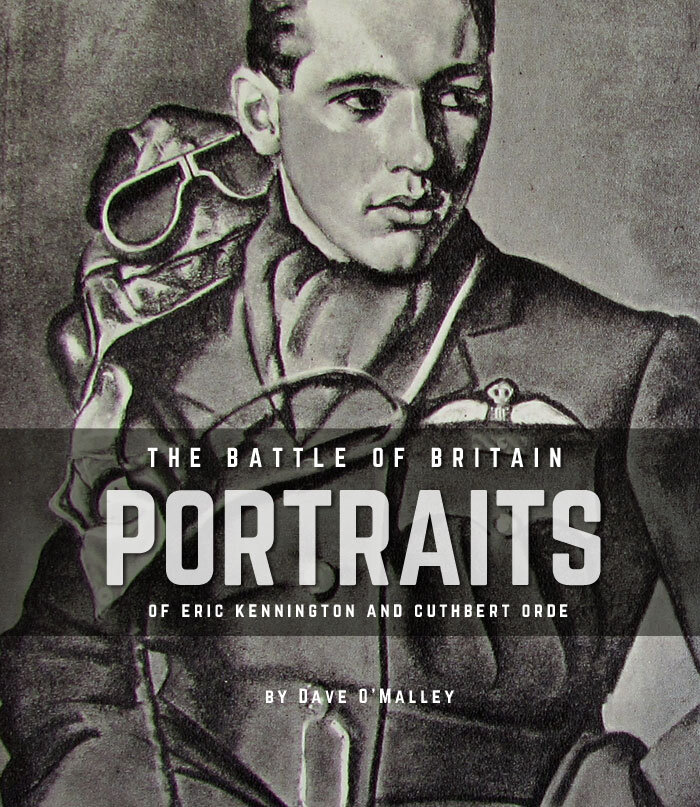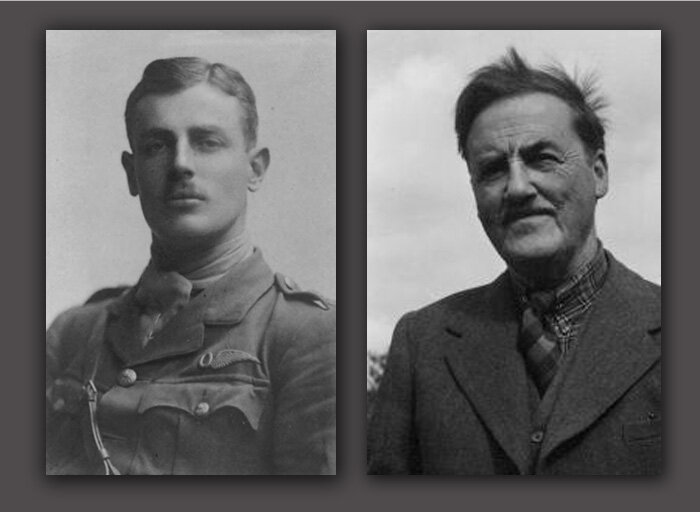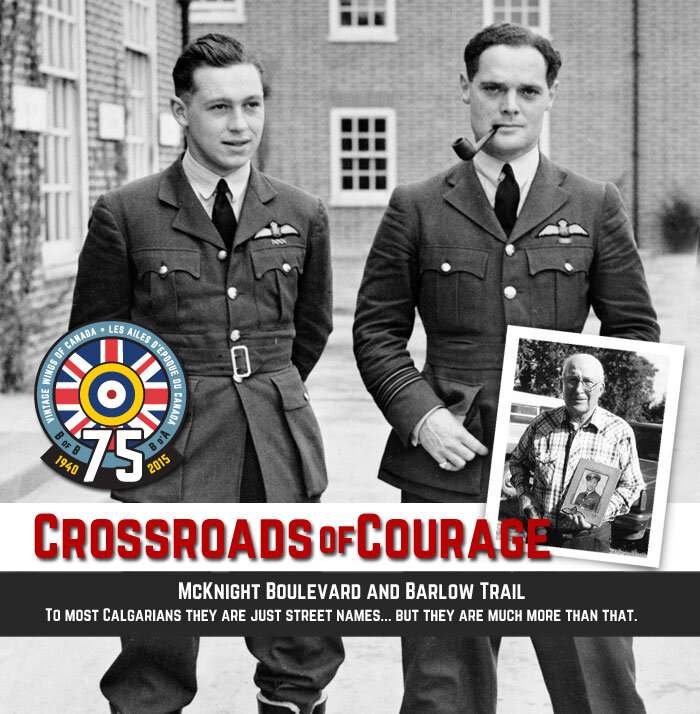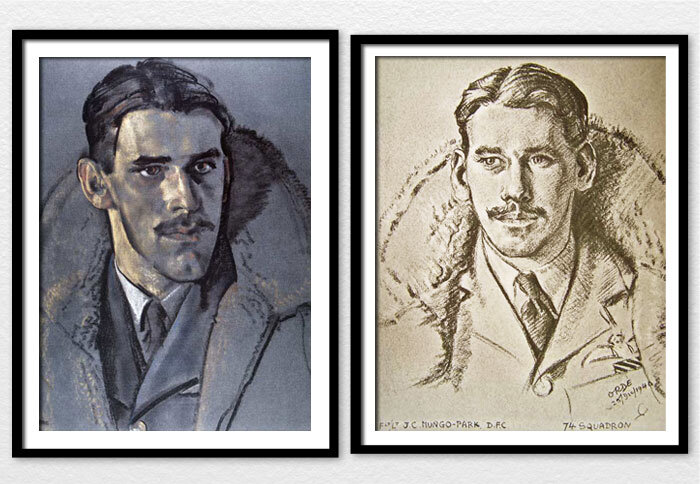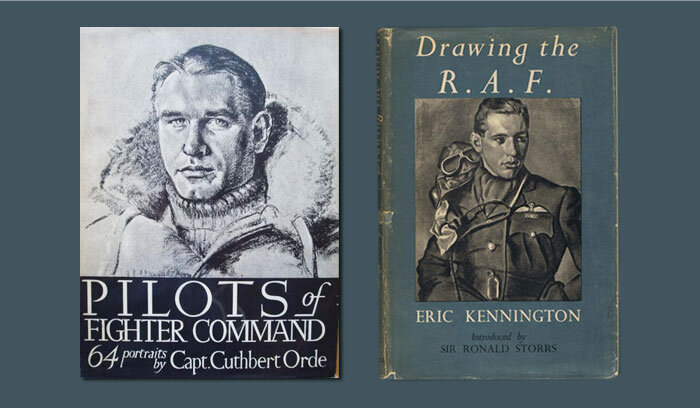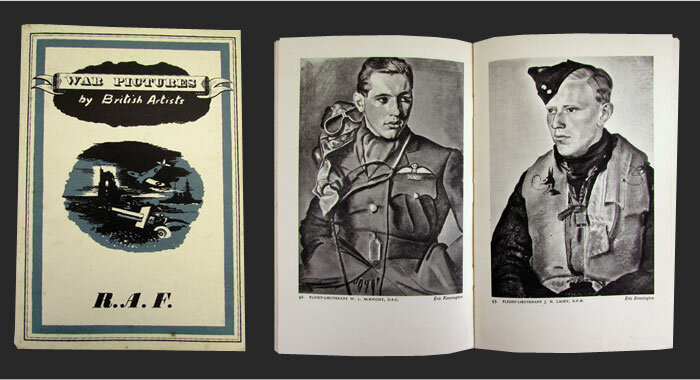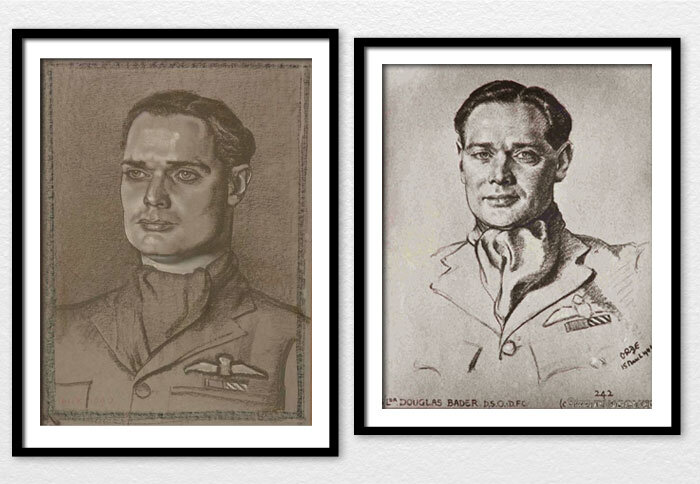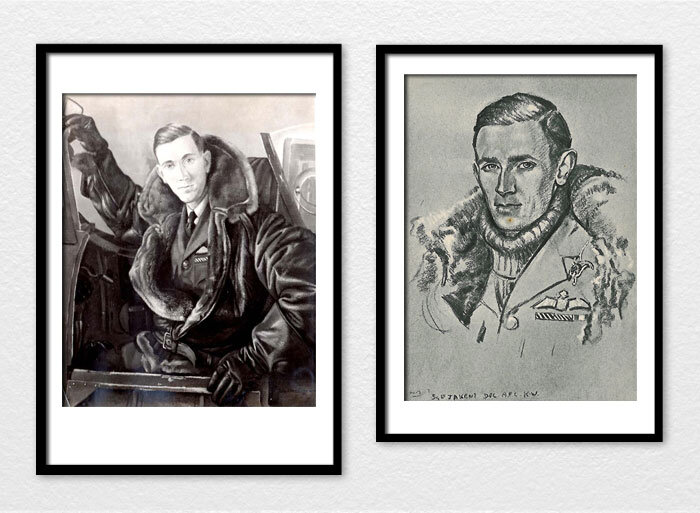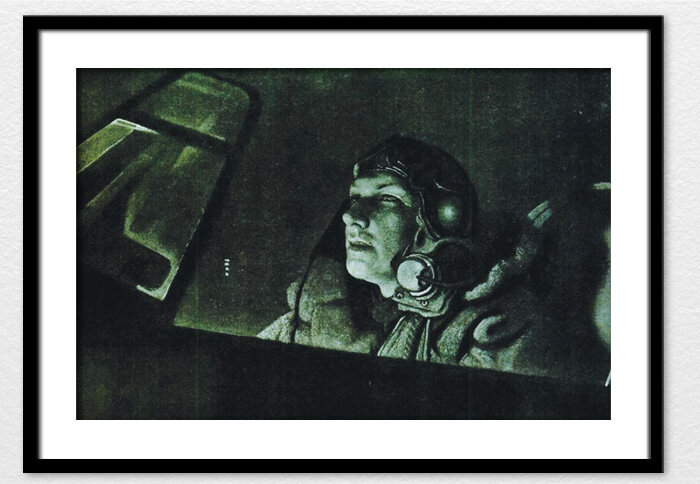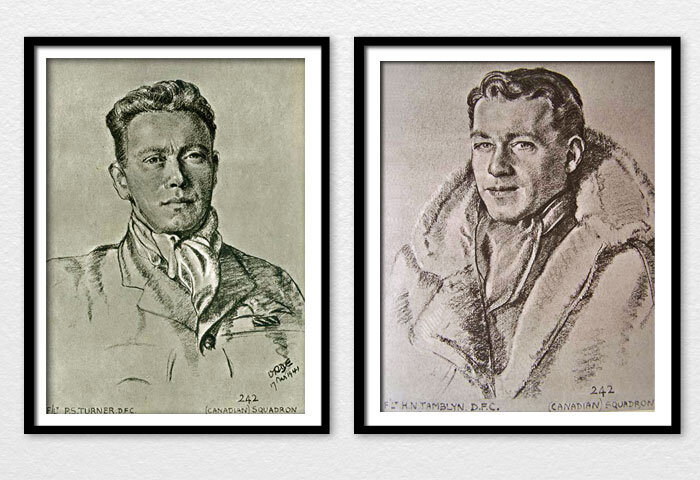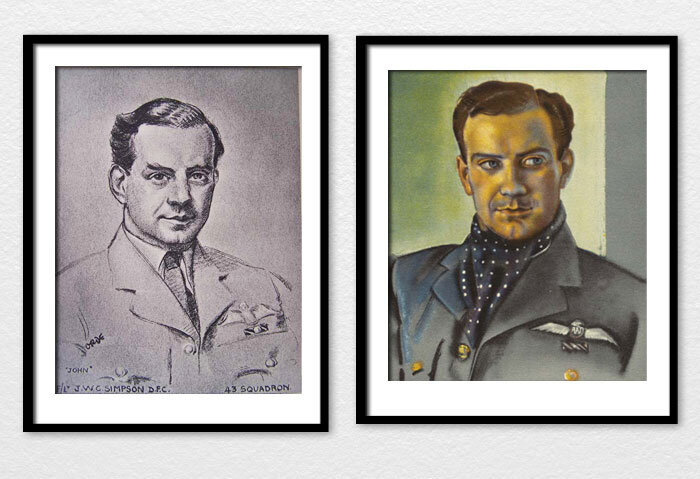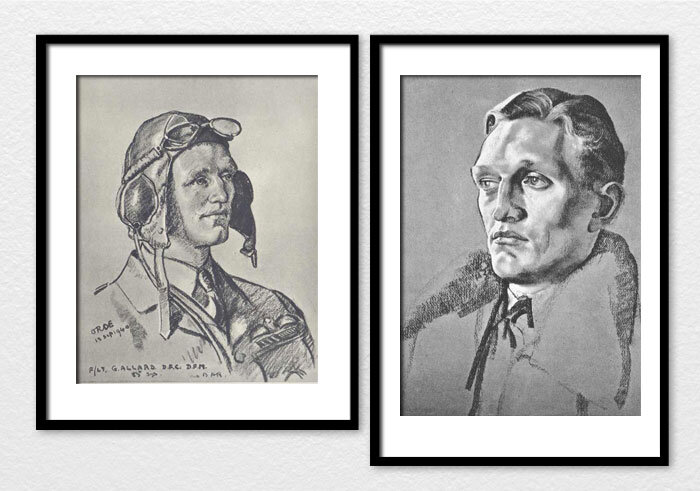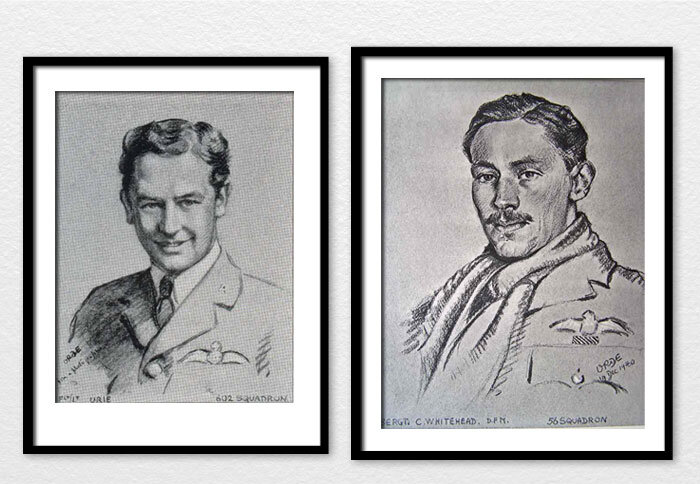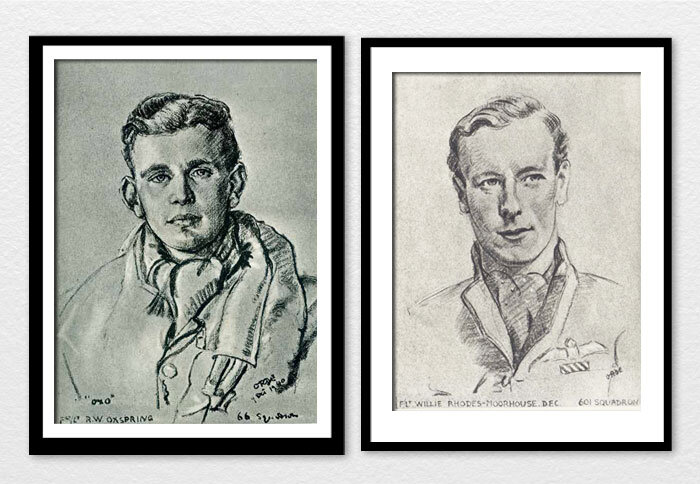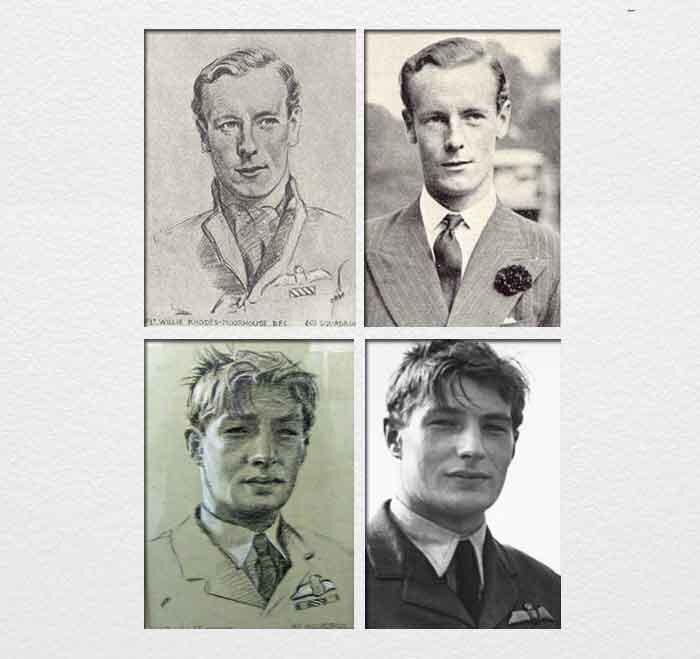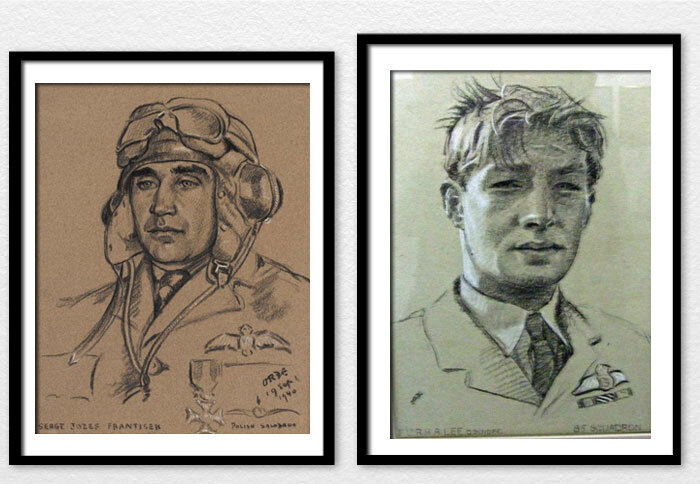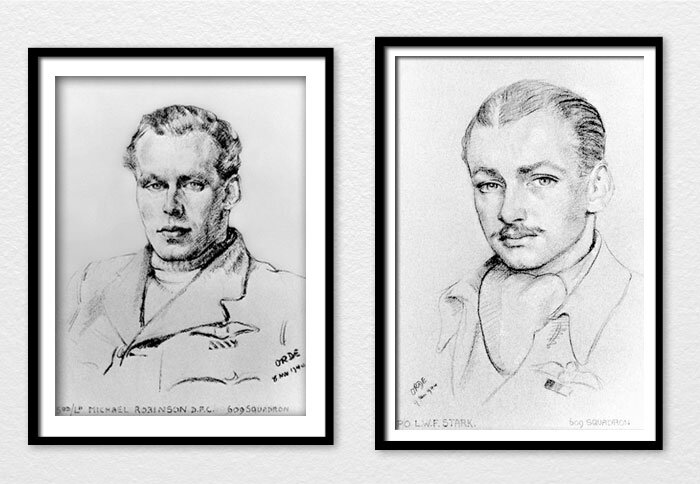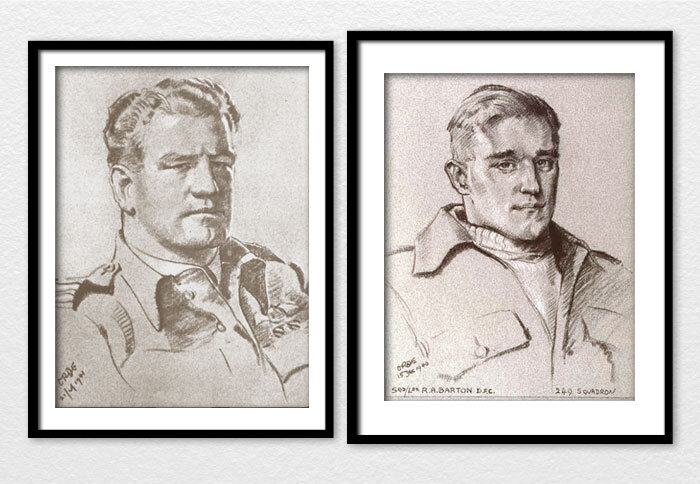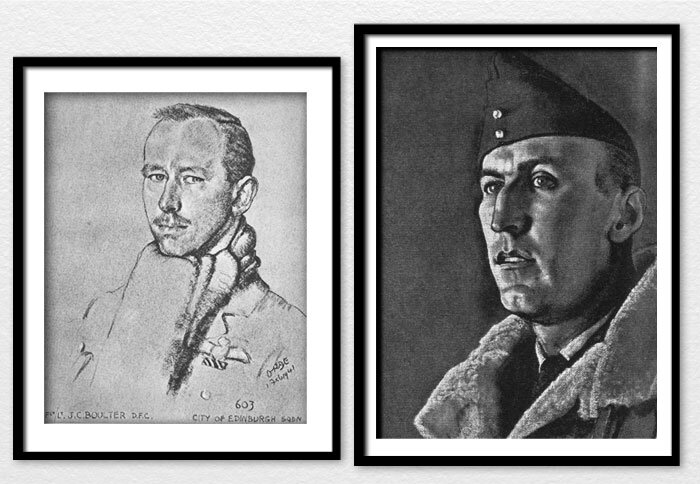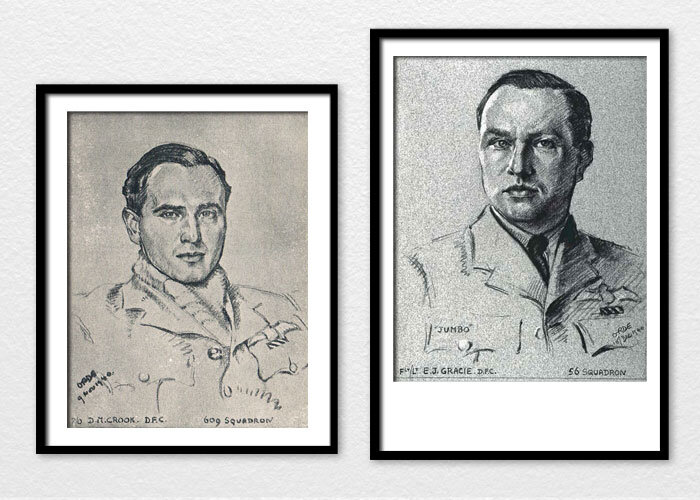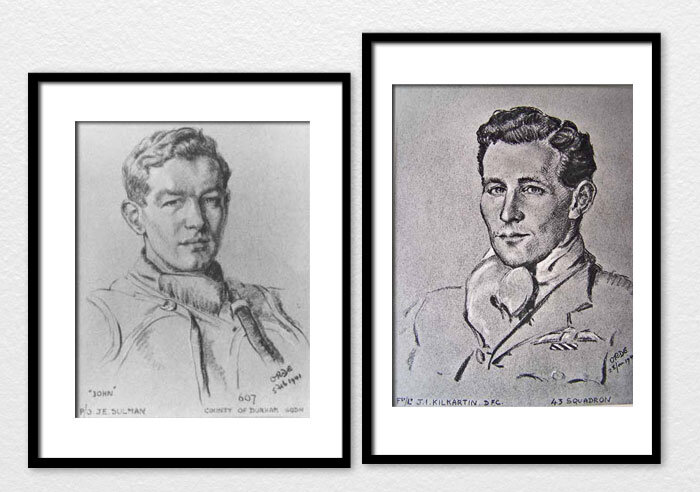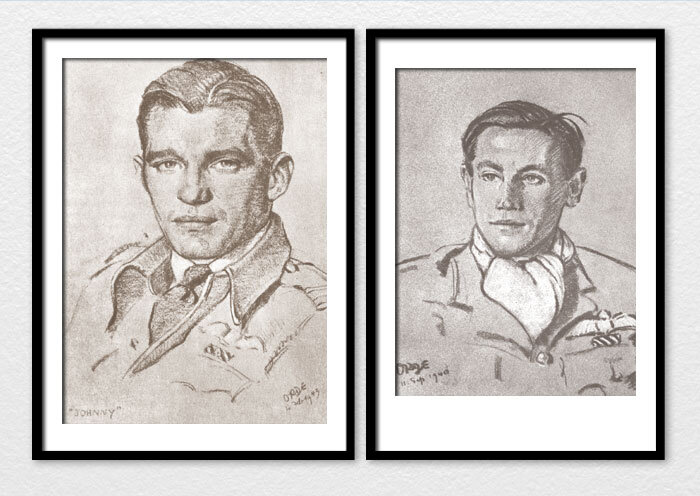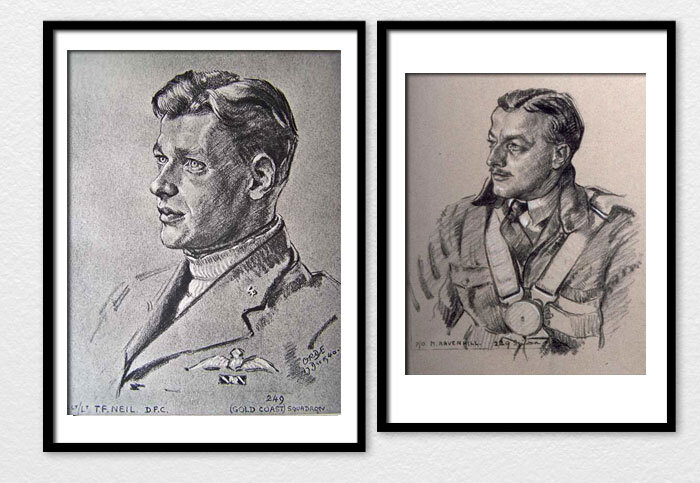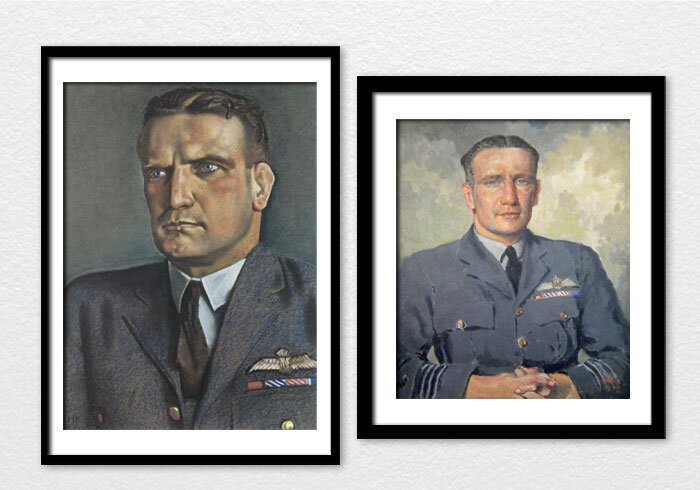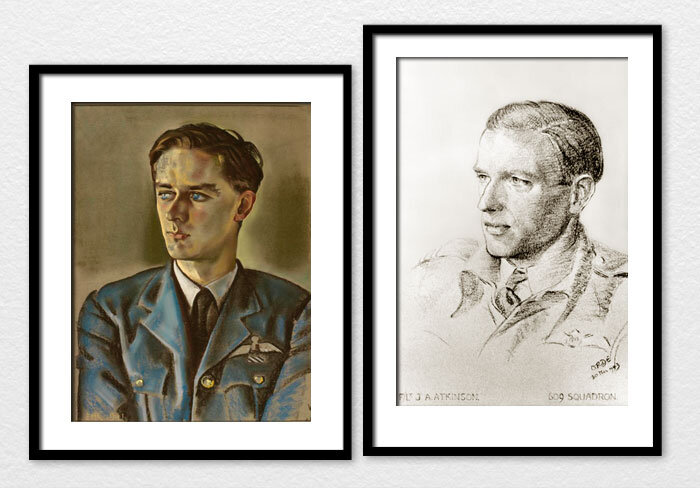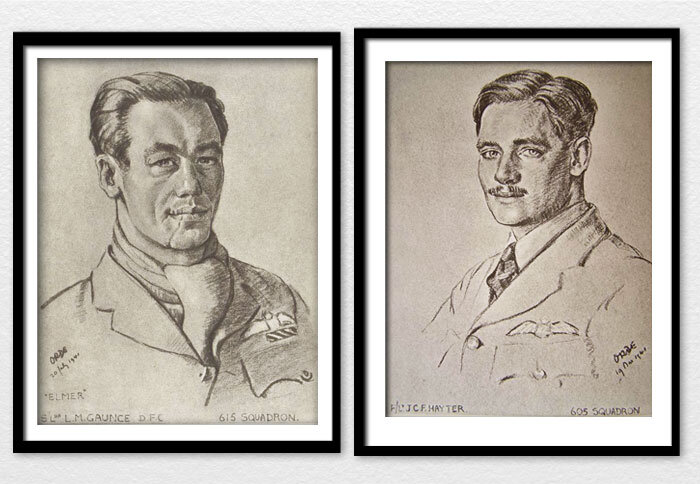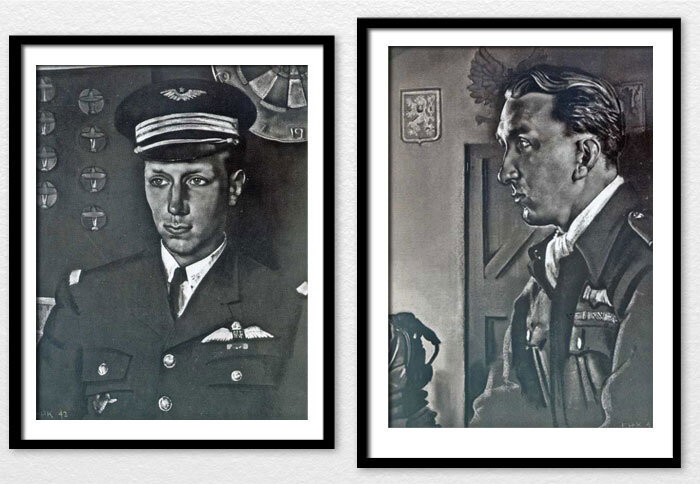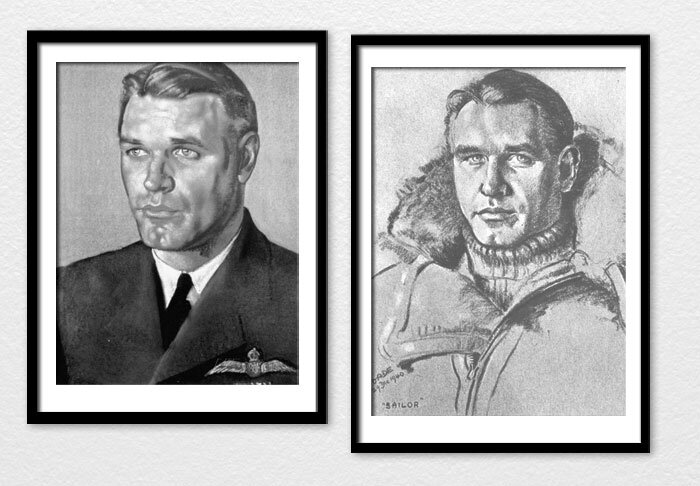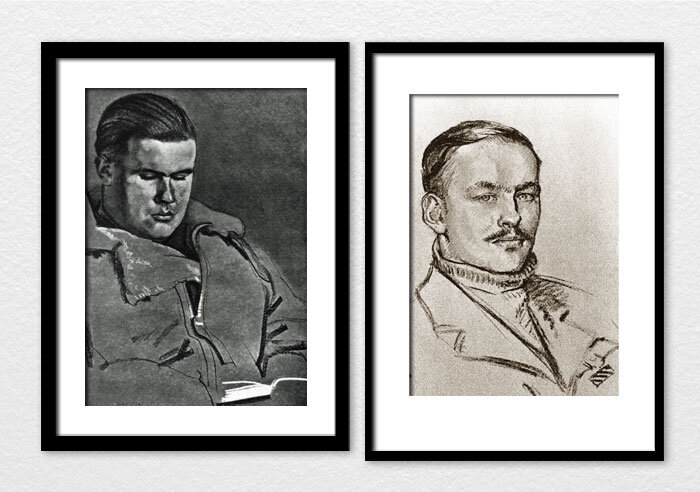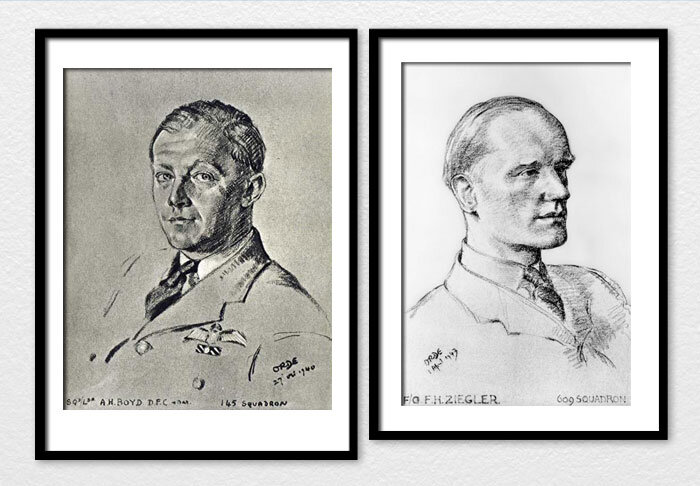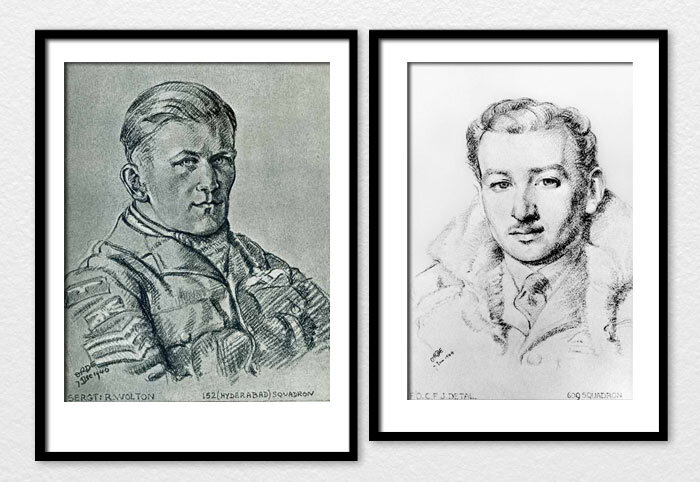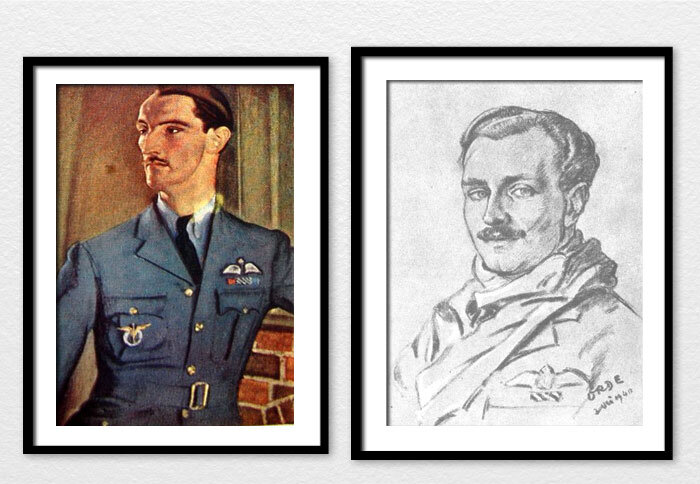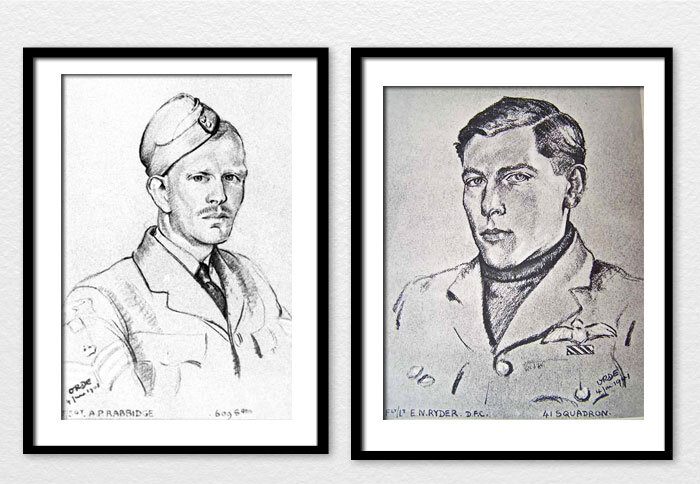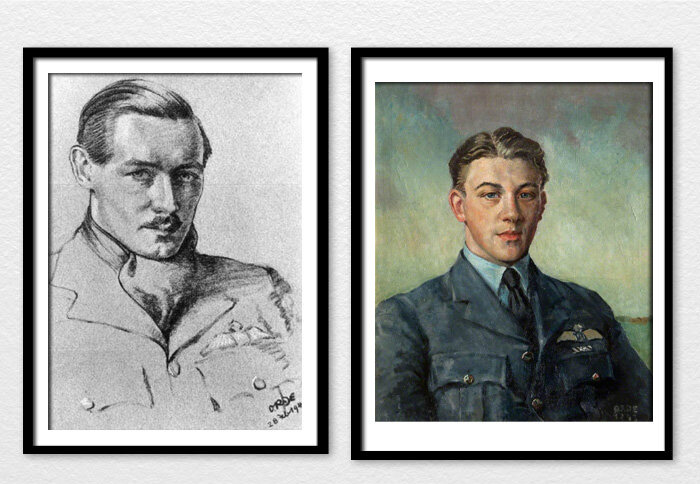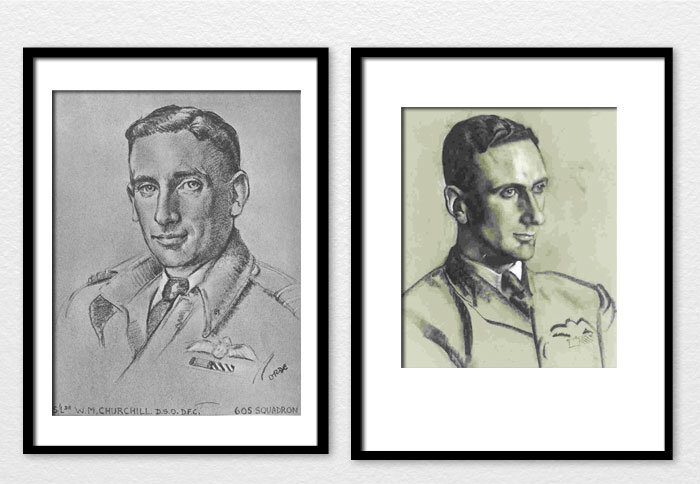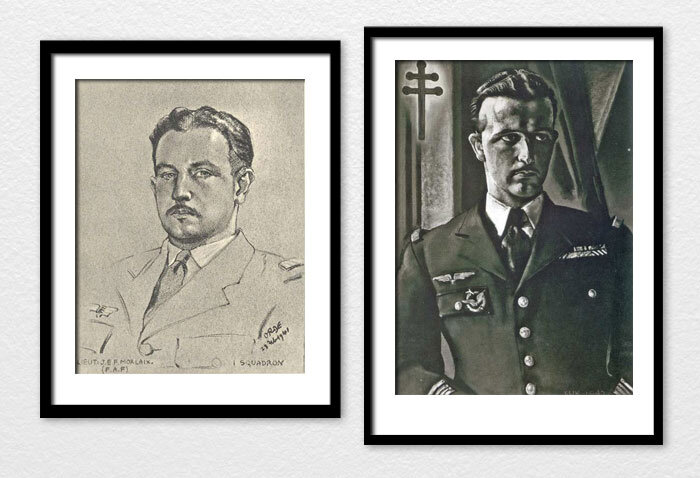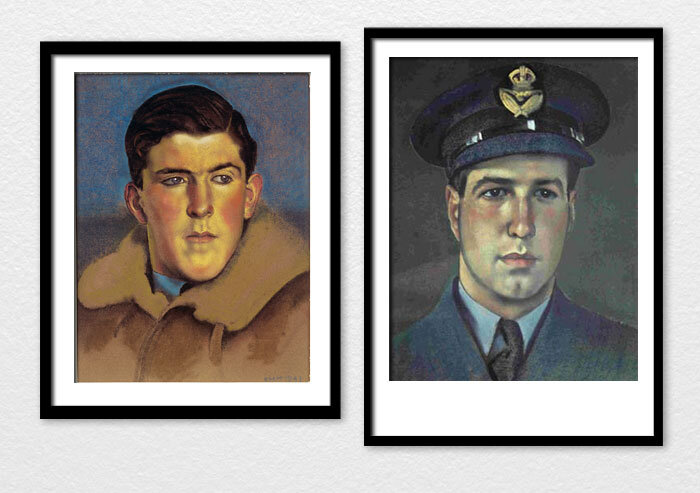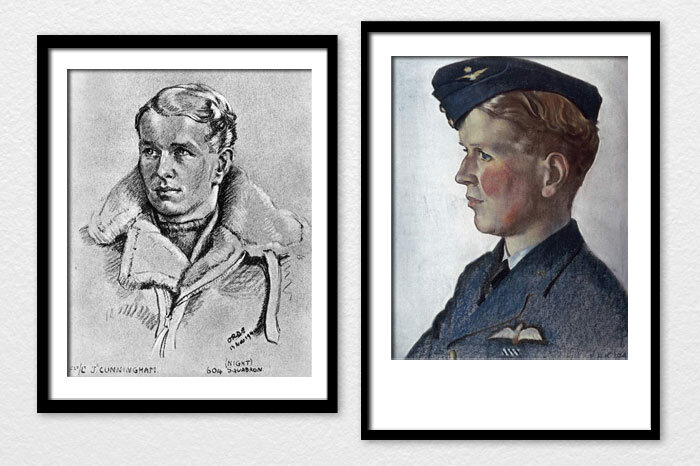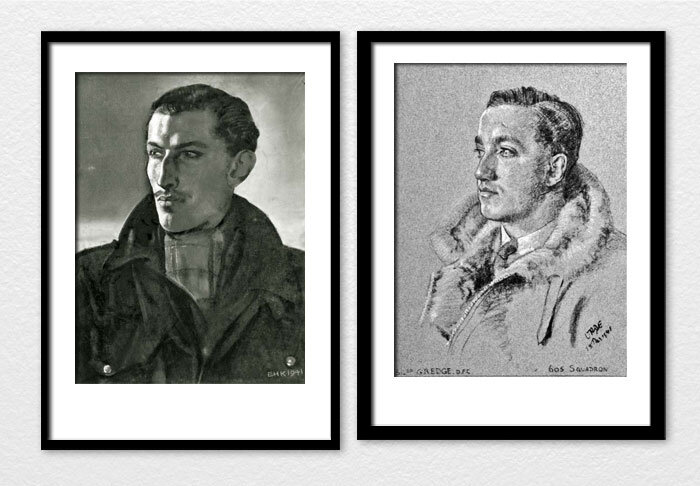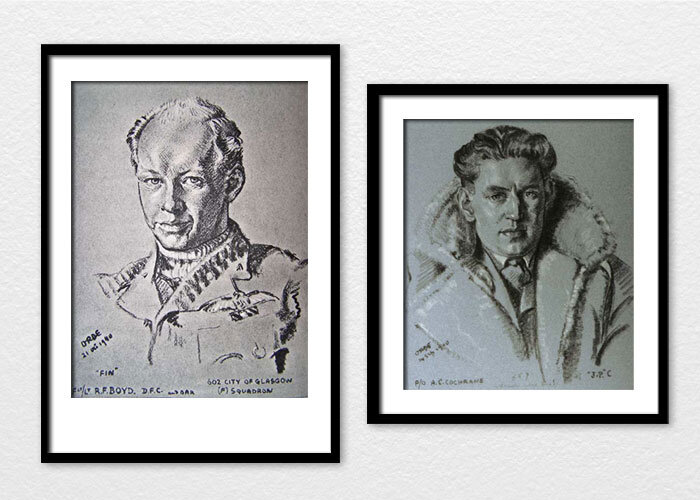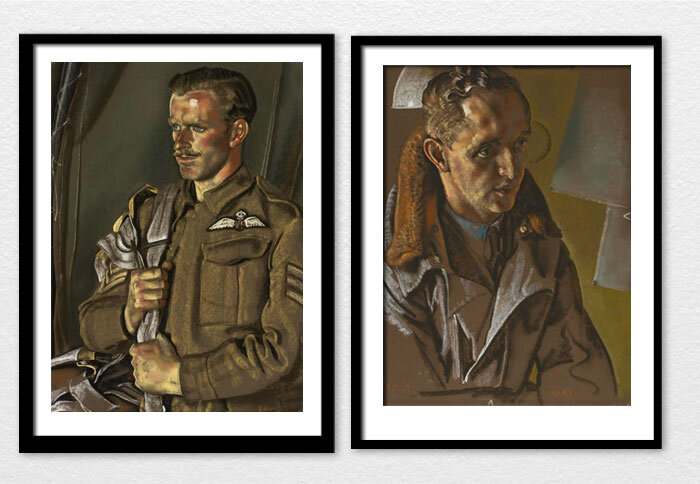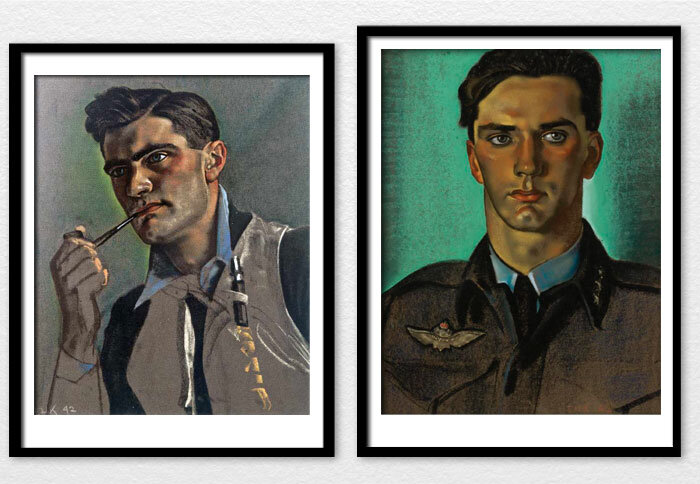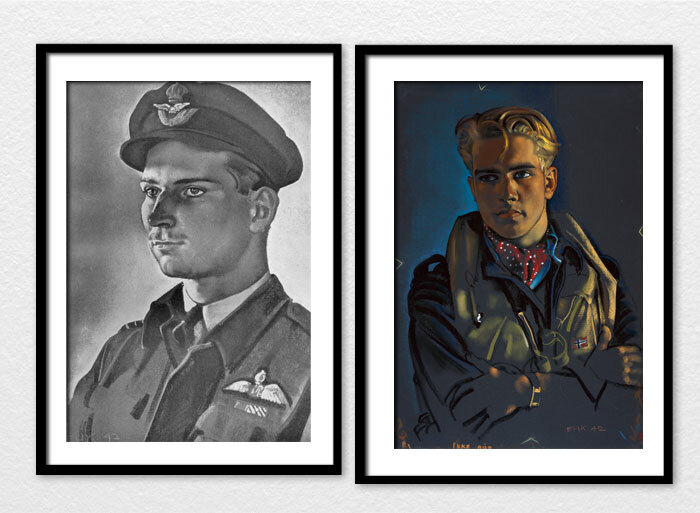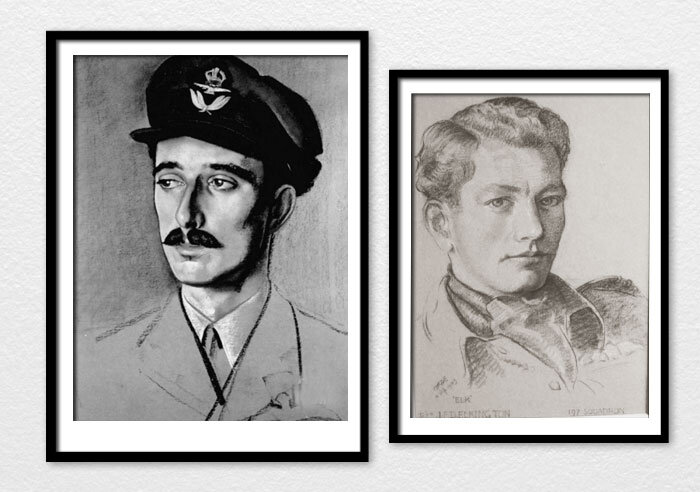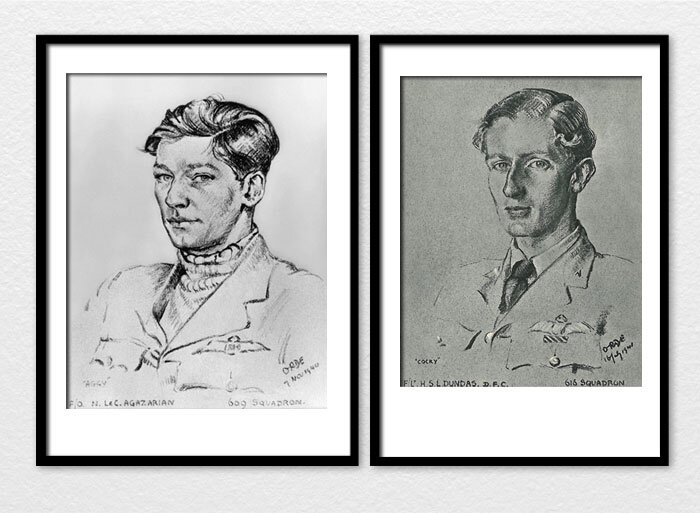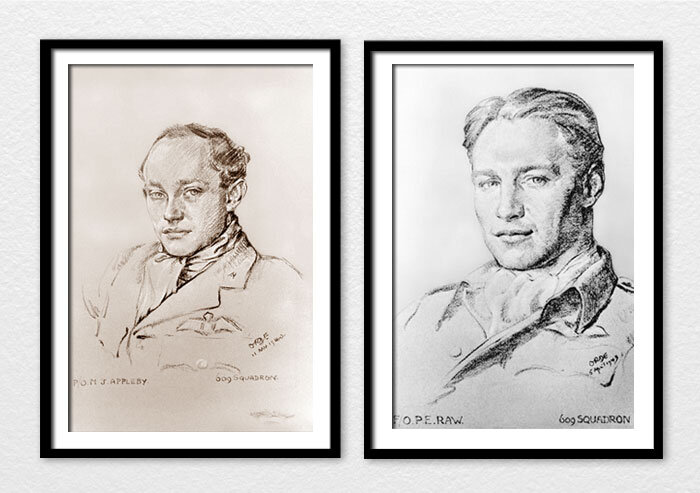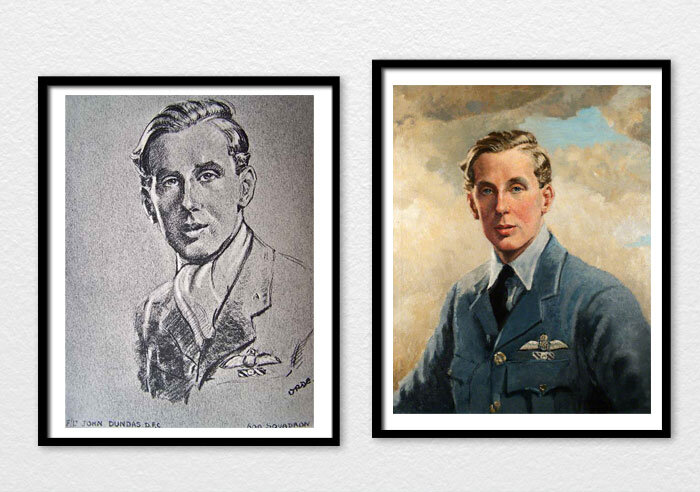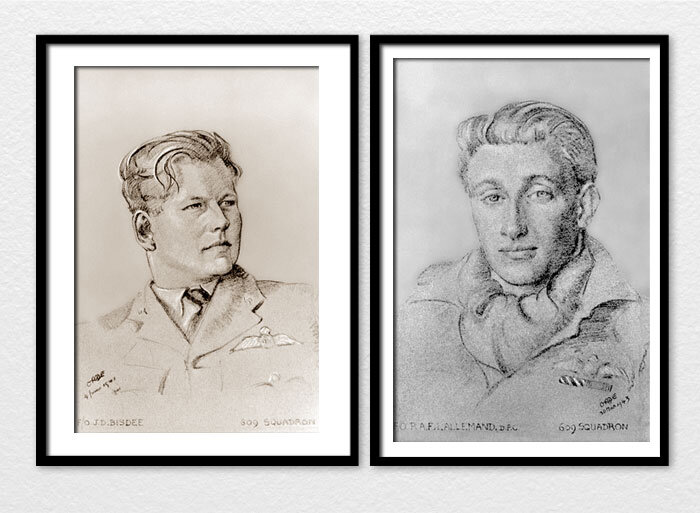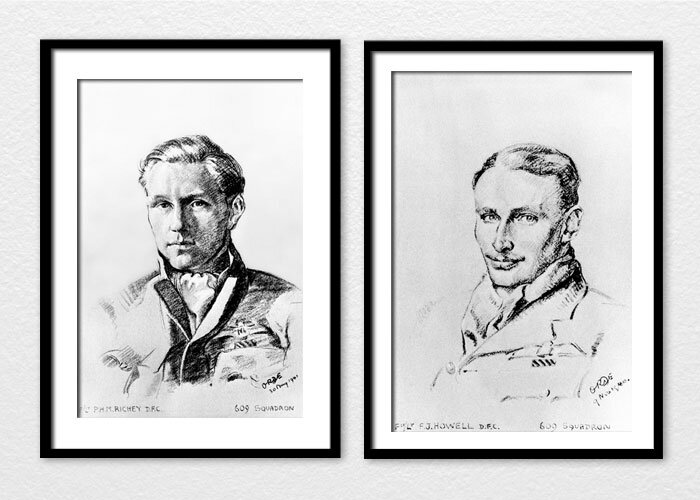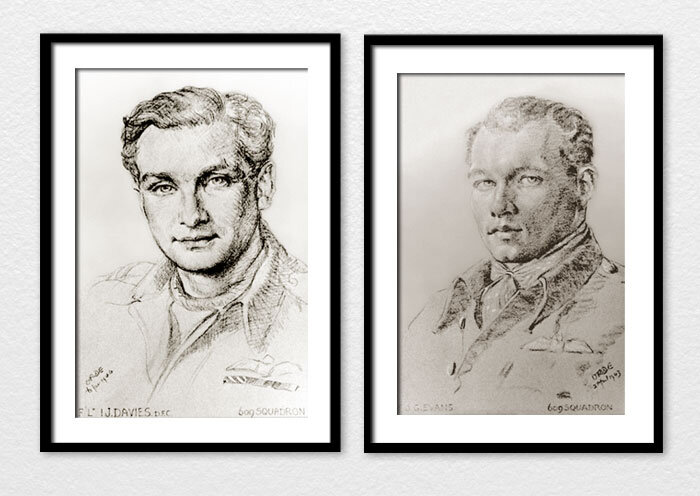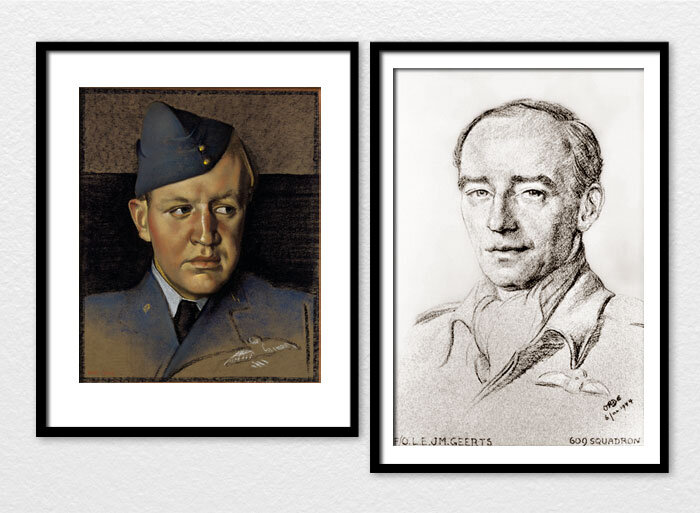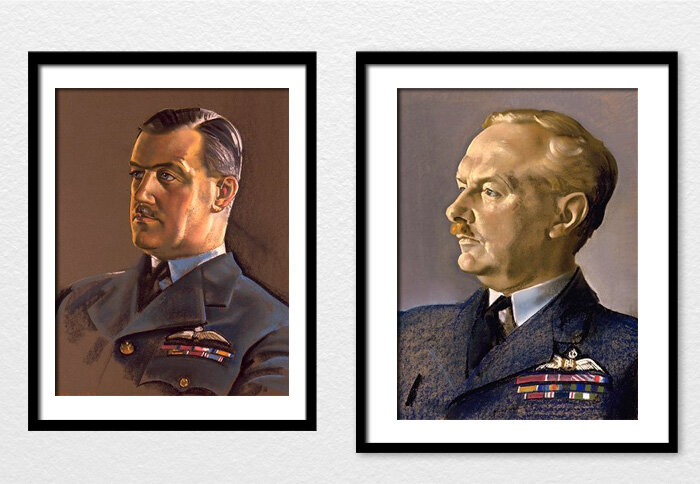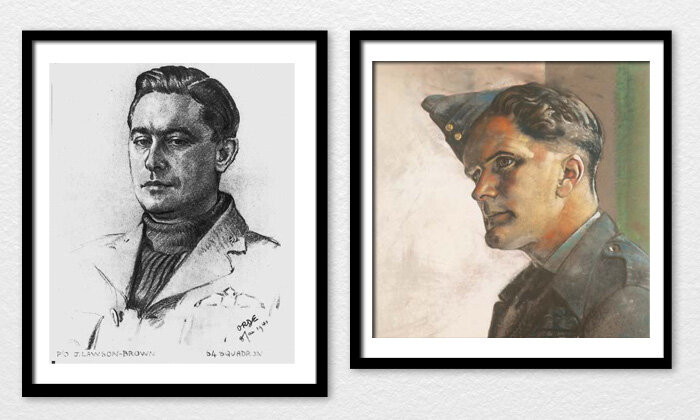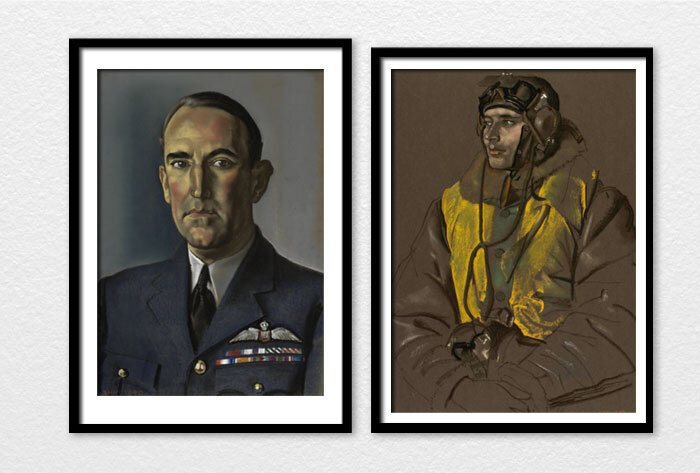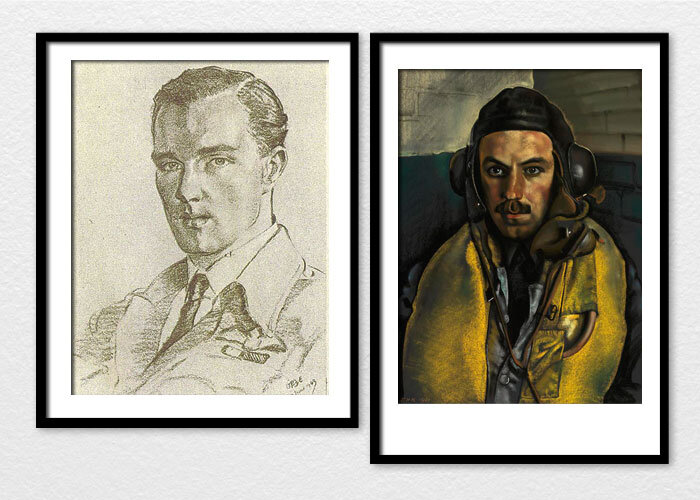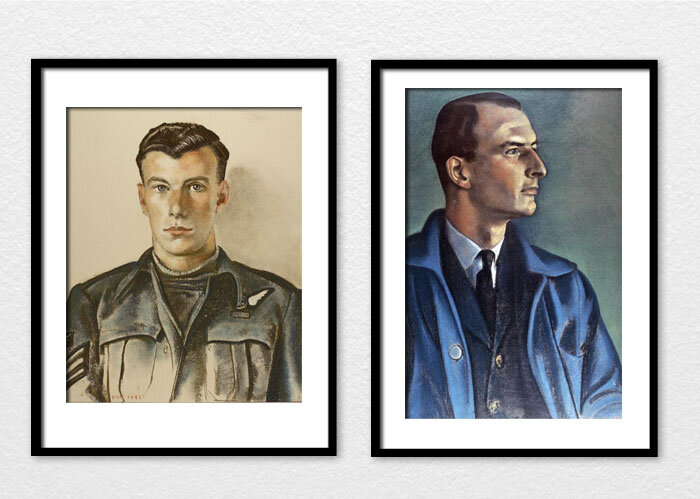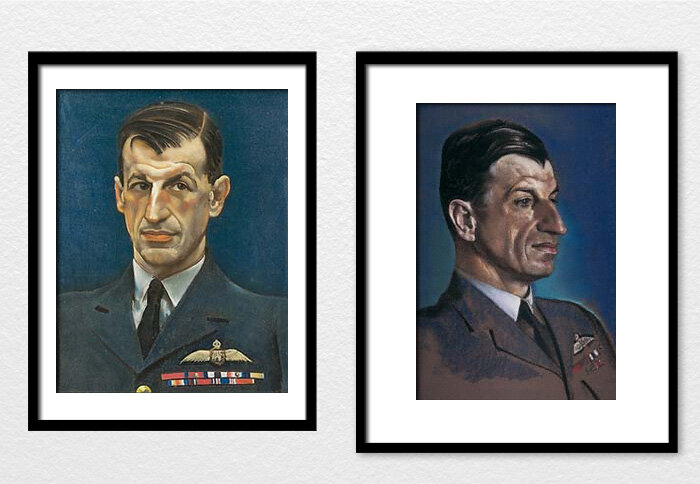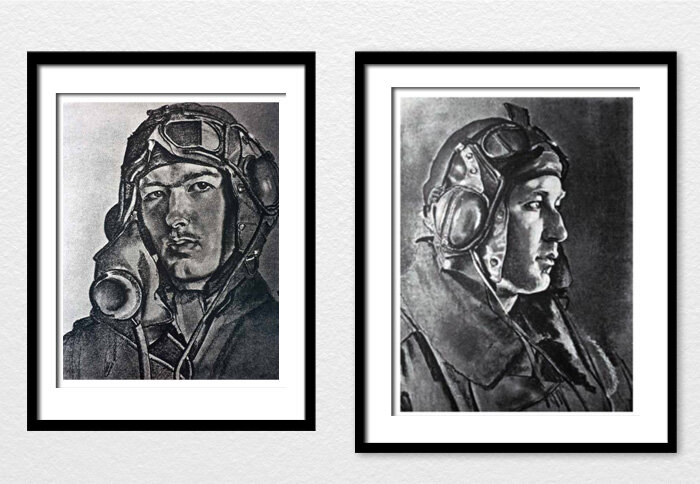THE BATTLE OF BRITAIN PORTRAITS
There is a certain indefinable, yet physical, series of facial phenomena that happens to very young men engaged in a battle in which there is a distinct possibility they may be killed or horribly wounded. Their faces become leaner, the features more taut, the eyes more distrustful, the skin prematurely lined, the countenances more... well, beautiful. Even the most homely of these men carry the “look”—that mixture of toughness, loneliness, determination, distance, fear, experience and confidence that gives to their once boyish faces a look of indescribable strength, character, sorrow and virile beauty.
Over the past ten years, researching and mining the Internet for background material and images for our stories, I have viewed thousands upon thousands of photographs of RAF pilots and aircrew. The photographs depicted young men in two ways—either the formal post-wings parade studio photographs taken for family and girlfriends or candid personal record shots of young men, beaming and exuberant, during their training days; wistful, tired and deeply aged just months later, after combat took its toll. These photographs, especially the personal snapshot, have a certain truth that is ours to interpret, leaving us to sort out the meaning of the smile, the reason behind the look of exhaustion, the story in the old eyes in a young man’s body.
From time to time, I would come across a portrait in charcoal or pastels that seemed to say something entirely different about an aviator—something that a photograph could not. As time went on, I began to save these portraits in a folder. Soon, I had more than forty such images of artists’ portraits. There were a number of portrait war artists whose works were in this folder, but the great majority of them were done by two men—Eric Henri Kennington and Cuthbert Julian Orde—during a period beginning during the Battle of Britain in the summer of 1940 and ending in 1944. The great majority of these portraits were of airmen who participated in, or were peripheral to, the Battle of Britain—either as leaders or contemporaries engaged by Bomber Command.
The subject of a studio photograph was asked to sit still for only a few seconds at a time, usually in the same lighting as every other subject. These photographers were, for the most part, true craftsmen, whose photographs were gorgeous expressions of light and manhood, considerably better than the average Walmart photographer that families flock to at Christmas time these days. But a sitter for a portrait artist like Kennington or Orde was required to sit for hours, even days, at a time. Often the artist would spend some time with his “sitter” or subject, getting to know him, allowing him to relax, to feel a certain ease. The act of simply being yourself and sitting for hours at a time seems to bring to the surface inner strength, nobility, weakness, sorrow and perhaps that person who dwells inside—the aggressive pugilist in New Zealander “Al” Deere, the smiling, almost sneering, disdain of Englishman “Archie” McKellar, the pain and sadness in the eyes of John Boulter.
Not long ago, I started to search the Internet specifically for portraits done by either Orde or Kennington and I was astonished, or rather gobsmacked, to discover the sheer amount of portraiture work each of these fine artists had created during the Second World War. One of the finest resources for me was the fabulous Battle of Britain London Monument (BBLM) website which lists, by country, every pilot who participated in the Battle of Britain, along with biographies of varying completeness and, where possible, photographs and images of any portraits painted of the subject by Orde or Kennington. The work that the team at the BBLM site has done is nothing short of awe-inspiring. They have come very close to collecting the personal stories of each of the nearly 3,000 pilots who participated. I highly recommend you take an hour or so to visit the site.
I decided that I would make an online repository for as many of their portrait works as I could assemble. Kennington was a prolific portraitist with many military portraits of men and women of the other services and even civilian war workers, but this repository would be only for airmen. Orde also did many war art works other than portraits. As the war began to produce a long list of heroic and tragic individuals, both Orde and Kennington, recognized war artists and former military men, were contracted by the Royal Air Force to do portraits of airmen—mostly pilots and senior commanders. For the most part, the RAF selected the sitters, mostly based on their successes as fighter pilots or leaders. These young men would pay a visit to the artist’s studio, or in the case of many of the subjects, at the Air Ministry in London where a small studio had been set up for the purpose.
It cannot be overstated that having one’s portrait commissioned by the Royal Air Force and being invited to the Air Ministry to sit, was a high honour for any of these young men. Author and art historian Jonathan Black, in his definitive work on Kennington: The Face of Courage: Eric Kennington, Portraiture and the Second World War, wrote of one particular Blenheim pilot who wrote to Kennington to express his gratitude: “Words cannot tell you how much I appreciate your portrait, or the privilege I feel at having the honour to sit for you. It is so incredibly like me and yet, I wish I had half the character you have portrayed and when I look at it, I know that it is the character that I want to be rather than who I am…”
John Boynton Priestly, author and social commentator, who wrote the introduction to a book which included some of Kennington’s portrait work, said this in The Face of Courage about the men who sat for the artist: “… I think that it can be said that they truly represent the middle classes from which they are drawn… These are some of the young men who are not only battling in the skies to preserve our present freedom but will also, with any luck, be among those who will help to build the future Britain.” Sadly, of the 98 portraits that follow, half the young sitters were dead by the end of the war or shortly thereafter, in accidents in the new jet age.
For my taste, the works of Kennington, dramatically impressionistic, stylish and heroic, inspire more emotion in me than Orde’s. At times, the sheer volume of Orde’s work and his robotic style comes close to what you might see from one of those gifted mall artists. But where Kennington’s sitters, for the most part, exude strength and heroic dash, Orde’s works display a wider range of emotions—doubt, exhaustion, aggressiveness and even fear. Both men captured something we cannot see.
It is important to state a few things about this repository of images of the works of Orde and Kennington. Firstly, some of the images which I found on the Internet are merely details from a slightly larger work (as in Geoffrey Tuttle’s portrait) and in almost every case, the colour is not correct. The edges of the art boards are cropped off in most cases, though this does not impact the work to any great extent. In several, the original is a colour pastel or oil work, but the only image found was a scan from a black and white reproduction in a book. These are quite simply the only scans from the original work that I could find.
Not all the images in this collection are of sitters who participated in the Battle of Britain. Many, like the 609 Squadron pilot series by Cuthbert Orde were done months and even years later, but they certainly find their roots in the Battle of Britain work that he did.
For me, this repository is like an art exhibit of the work of two of the greatest war artists of the Second World War. To allow their works to be seen in this light, I placed each piece in a frame and matte, and “hung” them on a wall, two at a time. Perhaps that is corny... but I like the effect.
It is also important to emphasize that these are by no means all the works in this niche by either artist and that if someone should take offense by the inclusion of one or more of the works, I would be happy to remove that piece or pieces. And, on the other hand, if someone would like to draw my attention to another for inclusion, by all means send it and perhaps the airman’s biography to accompany it. The biographies themselves are intentionally light, some longer than others for no particular reason. For information, I sourced histories from wikis, the Imperial War Museum, RAF Museum, BBLM and squadron association websites, blogs, forums and personal memoirs. I make no claim that they are authoritative in any way. They are meant to illustrate the depth of the service each man offered up. Should anything I included not be factual or incorrect in anyway, I would be delighted to hear from you and make the correction. The intention is to do honour to both Orde and Kennington and their sitters.
The biographies of each airman include the Gazetted Commonwealth decorations which they were awarded... to the best of my knowledge. They do not, however, include those decorations awarded to them from other nations such as Poland, France, America or Holland. Many of these great men were awarded these equally important decorations, but for brevity, I left them out. One can always search for these men on the Internet to see the additional “gongs” they were awarded.
Now, with all these caveats out of the way, let’s look at some powerful work. These were the Few, some of the finest men of the Second World War. None of them are alive today.
Both Cuthbert Orde (left) and Eric Kennington (right) were veterans of the First World War. Orde was a pilot and Flying Officer (Observer) with the Royal Flying Corps flying Maurice Farman aircraft. Two of his brothers also fought during the war. His brother Herbert was killed on HMS Goliath when it was torpedoed near the Dardanelles in May 1915 and his brother Michael, a pilot, was shot down in 1916 and captured. He was killed in a flying accident in 1920. Eric Kennington, like Orde, was born in 1888 and served in the war, fighting with the 13th Kensington Battalion, London Regiment. He was wounded while fighting on the Western Front and while recovering, he painted a large canvas, entitled The Kensingtons at Lavantie—of his unit resting and exhausted after battle. The painting made him an instant celebrity in art circles and after he recovered, he was sent back to the line, this time as a war artist. Photos: Orde, Wikipedia; Kennington: London Transport Museum
Related Stories
Click on image
Both Cuthbert Orde (left) and Eric Kennington (right) were veterans of the First World War. Orde was a pilot and Flying Officer (Observer) with the Royal Flying Corps flying Maurice Farman aircraft. Two of his brothers also fought during the war. His brother Herbert was killed on HMS Goliath when it was torpedoed near the Dardanelles in May 1915 and his brother Michael, a pilot, was shot down in 1916 and captured. He was killed in a flying accident in 1920. Eric Kennington, like Orde, was born in 1888 and served in the war, fighting with the 13th Kensington Battalion, London Regiment. He was wounded while fighting on the Western Front and while recovering, he painted a large canvas, entitled The Kensingtons at Lavantie—of his unit resting and exhausted after battle. The painting made him an instant celebrity in art circles and after he recovered, he was sent back to the line, this time as a war artist. Photos: Orde, Wikipedia; Kennington: London Transport Museum
Two sketches of John Colin Mungo-Park, DFC and Bar—Kennington’s on the left, Orde’s on the right. Mungo-Park joined the RAF on a short service commission in June 1937. His early assignment was as an anti-aircraft cooperation pilot attached to the Fleet Air Arm, flying the Fairey Swordfish. When war was declared, he transferred to Spitfires with 74 Squadron at RAF Hornchurch under the command of “Sailor” Malan. He flew throughout the Battles of France and Britain, becoming a double ace with 11 aircraft destroyed, 5 probables, and four damaged. Squadron Leader Mungo-Park, 74 Squadron, was killed in June of 1941 when his Spitfire was shot down over Adinkerke, Belgium. He is buried in Adinkerke Military Cemetery, just 60 miles from where is father, Lance Corporal Colin Mungo-Park, killed in the First World War, lay buried. Images via Battle of Britain London Monument
Cuthbert Orde and Eric Kennington both produced books after the Battle of Britain which featured their sketches, drawings and paintings of the Battle’s pilots. It is interesting to note that both Orde and Kennington chose a non-British fighter pilot to grace their covers. “Sailor” Malan, a South African, graces the cover of Orde’s Pilots of Fighter Command, while the Canadian “Willie” McKnight is featured on the cover of Kennington’s Drawing the R.A.F. Many of Orde’s sketches also appeared in Some of the Few, by John P.M. Reid, published in 1960. Images via internet
Eric Kennington’s colour pastel and chalk portraits were reprinted in black and white for this period booklet of war artists. One two-page spread features two of the great aces of the Battle of Britain—Canadian “Willie” McKnight (left) and James Harry “Ginger” Lacey. McKnight was the highest scoring Canadian and Lacey the second highest scoring British pilot of the Battle. Photos: Georgina Lander
Several pilots of the Battle of Britain and later conflicts were painted or drawn by both Cuthbert Orde and Eric Kennington—case in point, Squadron Leader (later Group Captain) Sir Douglas Robert Steuart Bader, CBE, DSO and Bar, DFC and Bar, MiD x 3,the famed legless fighter pilot of the RAF. Born in 1910 in London and raised in India, he joined the RAF in 1928 with a cadet posting to the RAF College at Cranwell. He joined 23 Squadron at RAF Kenley, flying the Bristol Bulldog. In 1931, whilst practicing aerobatics, he crashed attempting to roll his Bulldog at low level. He survived but lost both of his legs. While he remained in the RAF, he was not allowed to fly for what most would think to be obvious reasons. He left the RAF after a couple of years and joined Shell petroleum. When war broke out, he pestered the RAF to return to flying status and, despite his obvious handicap, passed several flying tests and was certified combat ready. He joined 222 Squadron and fought in the Battle of France and at Dunkirk, and showed himself to be a tenacious and very capable fighter pilot. In June 1940, he was given command of 242 Canadian Squadron, a unit with low morale following the Battle of France. He soon turned them into one of the finest squadrons of the Battle of Britain. Jonathan Black, in his book The Face of Courage: Eric Kennington, Portraiture and the Second World War, writes about Kennington’s feelings about Bader: “While drawing Bader and some of the pilots under his command, Kennington wrote to his brother: “I’m having a terribly good time. It’s more stage-like than I ever imagined. The OC here (Bader) has no legs and has been passed 100% unfit. But he is back and tears up into the sky like a hawk and nearly pulls the Germans out of their airplanes with his teeth and all his squadron have about a dozen each to their credit. I had forgotten we could produce such tigers...” ”
His tenacity and ability to lead men into battle marked him for promotion, and he left 242 in March 1941 to become Wing Commander (flying) at Tangmere. On 9 August, he was shot down, bailing out of his Hurricane and leaving one of his legs behind in the process. The Luftwaffe permitted the RAF to fly a truce mission to deliver a spare leg for Bader, but they soon wished they had not. Bader proved to be a difficult prisoner, attempting several escapes and he was soon sent to Colditz Prison (Oflag IV-C) where he joined other “incorrigible” prisoners. After the war, he flew with the RAF for a year, but retired and went to work for Shell Petroleum as manager of their fleet of aircraft. He fought tirelessly on behalf of physically handicapped children and remained a loyal friend to his many squadron friends. He died in 1982.
Two sketches by Cuthbert Orde—Wing Commander Brenden Eamon Fergus Finucane, DSO, DFC and two Bars (left) and Group Captain Gordon Roy McGregor, CC, OBE, DFC
“Paddy” Finucane, from Dublin, Ireland, was one of the most revered and capable of the early fighter pilots during the Battle of Britain and the following offensive ops over occupied France. Though Catholic and brought up in the “Early Troubles” and the Irish Civil War, his family moved to England and he developed an interest in aviation. His final tally was 28 victories, 5 probables and many more damaged. Finucane rose quickly to the rank of Wing Commander but was killed on 15 July 1942 when his Spitfire, which had been hit earlier over France, suffered an engine failure. Finucane ditched in the English Channel, but was killed or drowned. More than 2,500 people attended his memorial service at Westminster Cathedral. His name is inscribed on the Runnymede Air Forces Memorial, commemorating airmen lost in the Second World War who have no known grave.
Group Captain Gordon McGregor (a Squadron Leader by the Battle’s end) of Montréal, Québec learned to fly in the early 1930s after earning a degree in engineering from McGill University. He joined the Royal Canadian Air Force in 1936, receiving his wings two years later. The handsome McGregor was the oldest Canadian-born pilot in the Battle of Britain, becoming a Hurricane ace during the Battle with 401 Squadron (then called 1 Squadron) RCAF. With five confirmed victories, he was the squadron’s top scoring fighter pilot. McGregor’s Second World War career would include commanding X Wing—a Canadian wing of Kittyhawk fighters on operations in the Aleutians. Later, towards the end of the war, he commanded 126 Wing, a Canadian Spitfire Wing in Europe. After the war, he went to work as an executive for Trans-Canada Air Lines, becoming its president a few years later. He then was instrumental in transforming TCA into Air Canada, today still the largest airline in Canada.
Both Cuthbert Orde (right) and unknown-portraitist John A. Mossbridge (left) took a shot at a “Johnny” Kent portrait. Winnipeg-born Group Captain John Alexander “Johnny” Kent, DFC and Bar, AFC, is a true legend of the Battle of Britain. He was born in 1914 and learned to fly at the Winnipeg Flying Club in 1931 at the age of 17. He joined the RAF in 1935 and his first flying assignment was with 19 Squadron on Gloster Gauntlets, followed by the Royal Aircraft Establishment at RAF Farnborough. It was here that Kent deliberately crashed his aircraft into various barrage balloons—300 times!!! For his sterling service as a test pilot, he was awarded the Air Force Cross. He began his flying war as a Spitfire photo-recon pilot with the Photographic Development Unit. He was shot down whilst on a low-level sortie in France, but survived. He then joined 303 Polish Squadron, RAF in command of “A” Flight. He earned the love and admiration of his Polish pilots, many of whom spoke no English. He eventually led the entire Polish Wing of four squadrons, thereby earning himself the nicknames Kentowski and Kentski. Of the four Polish squadrons in his charge, he had this to say: “I cannot say how proud I am to have been privileged to help form and lead No. 303 Squadron and later to lead such a magnificent fighting force as the Polish Wing. There formed within me in those days an admiration, respect and genuine affection for these really remarkable men which I have never lost. I formed friendships that are as firm as they were those twenty-five years ago and this I find most gratifying. We who were privileged to fly and fight with them will never forget and Britain must never forget how much she owes to the loyalty, indomitable spirit and sacrifice of those Polish flyers. They were our staunchest Allies in our darkest days; may they always be remembered as such.” Kent accounted for 13 enemy aircraft shot down. He survived the war, retiring as a Group Captain, working in the business world, and eventually dying in 1971 in Germany. In his portrait by Orde, he appears to be wearing a Polish pilot’s brevet suspended just above his RAF wings.
For many reasons, this is my favourite of all of Kennington’s (or Orde’s) portraits of pilots in the Second World War, for it shows a pilot in his element—the cockpit of his Hawker Hurricane night fighter as he prepares for takeoff. His face is lit from below by the lights of his instruments and the lighting in his dispersal area. The pilot in this study called “Night Flyer at Readiness” is Flying Officer Richard Playne Stevens, DSO, DFC and Bar. Stevens was born in 1909 in Tonbridge, Kent, one of five brothers and one sister. In his late teens, he worked on a cattle ranch in Australia and then later as an officer with the Palestine Police. In 1936, he returned to England, took flying lessons and then took a job flying with commercial airlines, mostly flying at night and across the English Channel. He joined the RAF Auxiliary in 1937 and was accepted permanently with the RAF in 1939. At 30 years old, he was at the upper limit for new officers hoping for a flying career. His more than 400 hours as a night passenger and mail pilot made him a good candidate for a night flying position however. His early RAF assignment was flying de Havilland Rapides (the same type he flew commercially) on searchlight and anti-aircraft artillery tests at night. Stevens’ first operational posting was 151 Squadron in October of 1940—one of the new night fighter specialist squadrons. Stevens’ first victory came on the night of 15–16 January 1941 and he went on to become one of the finest night fighter pilots of the war with 14 confirmed victories. Later he joined 253 Squadron, flying Hurricane night intruder and night fighter missions and in mid-December 1941 he failed to return from a night mission over Holland. The next day, German soldiers found the wreck of his Hurricane (and his body) and that of the Junkers Ju 88 he had shot down just 600 metres apart. He apparently flew into the ground as he shot down the landing Ju 88. The famous fighter ace and admired wing leader “Johnnie” Johnson had this to say about Stevens: “To those who flew with him it seemed as if life was of little account to him, for the risks he took could only have one ending ... We have the fondest memories of him.”
Two of my favourite pastels by Eric Kennington—on the left is Flight Lieutenant Richard Hope Hillary and on the right is Flight Lieutenant Alistair Lennox Taylor, DFC and 2 Bars, MiD
During the war, Hillary became one of the best known pilots of the Battle of Britain, not because he was an ace, but world famous for writing about his experiences and his struggle to overcome burns and wounds suffered in combat. Hillary was born in Australia, but moved to England at age three. He attended Trinity College, Oxford where he excelled as an athlete and joined the university’s air squadron. He was called to service a month after the declaration of war. After flight training, he joined 603 Squadron, flying Spitfires from RAF Dyce and then RAF Hornchurch. After claiming his first victory, he was shot down, crash-landing without injury. On 3 September, the day he became an ace with his fifth confirmed victory, he was himself shot down—in flames. He bailed from his aircraft over the North Sea and was rescued, but horrifically burned about his hands and face. He spent months in hospital and became a patient (known as “Guinea Pigs”) of the groundbreaking plastic surgeon Dr. Archibald McIndoe. During this difficult recovery, he wrote and published The Last Enemy, a book about his life as a fighter pilot and his fight to recover. It was a worldwide literary hit and remains today as one of the most honest and powerful stories of the life of a fighter pilot on squadron during the Battle of Britain. His biographer, Denis Richards wrote “The author was acclaimed not only as a born writer but also representative of the doomed youth of his generation, although in his constant self-analysis he was in fact a most untypical British fighter pilot of 1940.” He regained his flying status despite hands that were crippled and mangled by burns, and went on to train on Bristol Blenheim night fighters. He died along with his navigator while holding over a beacon at night—icing was thought to be the probable cause, but his disfigured hands may have been factors. He was 24 years old. The portrait by Kennington shows him after surgery in 1942, with his eyelids burned away, staring off into a hard light. Kennington and Hillary became friends during this process.
Alistair Taylor was born in Worcester in 1916. He was appointed to a commission in the RAF in November of 1936 and served during the Battle of France with 226 Squadron on the Fairey Battle. Being in a photo reconnaissance squadron, he did not qualify as a Battle of Britain pilot, yet during the period of the Battle, he received two DFCs—one in July 1940 and the other in October. The citation accompanying his second DFC reads: “In September 1940, this officer carried out a successful photographic reconnaissance of the Dortmund-Ems aqueduct. Flying Officer Taylor took off from his base in dense fog but, flying through this, he reached his objective and secured valuable photographs, from a height of 6,000 feet. He has, during the last two months, carried out a number of exceptionally successful reconnaissances, including one over Kiel which was considered the most valuable reconnaissance completed for the Navy during the war.” He received a third DFC the following March. On 14 December 1941, Taylor, then an acting Squadron Leader, disappeared over the North Sea or Norway during an operation. He was just 25.
Pilot Officer John “Jack” Urwin-Mann, DSO, DFC and Bar (left) and Flight Lieutenant Phillip Henry “Pip” Barran—sketches by Cuthbert Orde
“Jack” Urwin-Mann was born in Victoria, British Columbia, Canada, but was raised in England by British parents. He was claimed as a native by both countries, but it is telling to note that he is listed on the Battle of Britain London Monument as Canadian. As with all the Battle of Britain pilots, he joined before the war, in March of 1939. He was posted to 253 Squadron at RAF Manston in January 1940 and was quickly caught up in the Battle of France. After 253 Squadron was withdrawn having suffered heavy casualties, he was transferred to 238 Squadron at RAF Tangmere. He fought with distinction throughout the Battle of Britain and later in the war. He was awarded his first DFC for his actions in the Battle of Britain, a second one in 1942 and a Distinguished Service Order (DSO) in 1943. His personal score at war’s end was nine victories. He survived the war, retiring from the Royal Air Force in 1959 and died of natural causes in 1999.
Flight Lieutenant P.H. “Pip” Barran (Orde spelled his name incorrectly on his drawing) was a Spitfire pilot with 602 City of GlasgowSquadron. He was born in Leeds in 1909. Before the war, he was a manager of a brickworks at a colliery owned by his family. He joined 609 Auxiliary Squadron in 1937 and was made “B” Flight Commander in 1939. He was flying a convoy escort patrol when he was attacked and shot down by a Messerschmitt Bf 109 on 11 July 1940. He successfully bailed out of his burning Spit, landing in the water five miles off Portland Bill, was picked up, but later died of his wounds and burns. He was 32 years old.
Two of the Canadian Hurricane fighter pilots of 242 Squadron—Flight Lieutenant Stan Turner, DSO, DFC and Bar (left) and Flight Lieutenant Hugh Tamblyn, DFC
Percival Stanley Turner was one of the original 242 pilots who flew in the Battle of France as well as the Battle of Britain under Squadron Leader Fowler Gobeil. Turner holds the record for the most combat ops flown by a Canadian (500). Turner transferred to the RCAF in 1944 and remained in that service after the war. He died in Ottawa in 1983 at the age of 70.
Hugh Norman Donald Tamblyn was born in Watrous, Saskatchewan and joined the RAF in June of 1938. His early flying career was as a Boulton Paul Defiant turret fighter pilot. He then transferred to 242 Canadian Squadron during the Battle of Britain, shooting down 5 enemy aircraft and sharing in the destruction of another. Sadly, Tamblyn, aged 23, was killed in action with 242 Squadron on 3 April 1941. He had radioed that he had been hit by return fire from a Dornier Do 17 and his Hurricane was on fire. A search of the North Sea recovered his uninjured body. He had died of exposure.
Two of the greatest Canadian fighter pilot legends of the Second World War—Squadron Leader Alfred Keith “Skeets” Ogilvie (left, as a Flying Officer, sketch by Cuthbert Orde) and Flying Officer William Lidstone “Willie” McKnight, DFC and Bar (by EricKennington)
Ogilvie was from Ottawa, Ontario, growing up just four blocks from where I am writing this. He joined the RAF in 1939, and made his way quickly through pilot training, arriving on squadron with 609 West Riding Squadron at RAF Middle Wallop, flying Spitfires. He fought admirably through the Battle of Britain, with a score of six victories and was shot down while escorting bombers over France. He managed to bail out, but he was badly wounded. He was captured, spent the next nine months in Belgian hospitals. Upon his recovery, he was sent to Stalag Luft III, where his true legendary status was created. It was here that he became a key member of the escape committee for the Great Escape. He was one of the last of the 76 who managed to escape, and remained at large for two days. He was subsequently captured and interrogated. Fifty of the 73 who were recaptured were murdered by the Gestapo and the SS—shot singly or in pairs (not all at once as Hollywood would have you believe). Ogilvie was one of the lucky ones who was not murdered. He joined the postwar RCAF and flew transport aircraft with 412 Squadron and retired in 1962. He died in 1999 in Ottawa.
Flying Officer “Willie” McKnight, of Calgary, Alberta is perhaps the most celebrated Canadian of the Battle of Britain. McKnight, jilted by his girlfriend whilst attending medical school at the University of Alberta, quit his studies and travelled to England on his own money to enlist in the Royal Air Force in 1938. McKnight, an enfant terrible with his wild, rebellious ways, cut quite the swath through his squadrons, being confined to barracks on two occasions, held in open arrest as “perpetrator of a riot”. McKnight was credited with 18 victories and was Bader’s preferred wingman. He survived both the Battle of France and Britain, but was shot down over the English Channel in January of 1941. He was the fourth highest scoring Canadian fighter pilot of the Second World War.
Flight Lieutenant John William Charles Simpson, DFC and Bar, as portrayed by Orde (left) and Kennington (right). The British-born Simpson joined 43 Squadron on Hawker Furies in October 1936, with the war still three years away. His first victory over the Germans was in February 1940. After his 8th victory, he was shot down in July of 1940, surviving with injuries. After recuperation, he rejoined 43 Squadron. In December of 1940, he was given command of 245 Squadron at RAF Aldergrove. By war’s end he had a personal score of 9.5 victories and had achieved the rank of Group Captain. He continued with the RAF after the war until his death by suicide in 1949.
Flight Lieutenant Geoffrey “Sammy” Allard, DFC, DFM and Bar by Cuthbert Orde (left) and Eric Kennington (right). Allard was born in York, England in 1912. He joined the RAF in 1929, at the age of 17, qualifying as a Leading Aircraftman mechanic. But “Sammy” wanted to fly and so he applied to be a pilot and was accepted. He joined 87 Squadron in 1937 as a Sergeant pilot, flying the Gloster Gladiator and then with the newly reformed 85 Squadron at RAF Debden, flying Gladiators at first then the Hawker Hurricane. Allard was a fine fighter pilot and in the Battle of France, he scored at least 8 victories. For his fighting spirit, Allard was awarded the Distinguished Flying Medal (the equivalent of a DFC, but for non-commissioned officers). He continued to mount victories through the early months of the Battle of Britain. For his actions, he was commissioned in August and then quickly promoted to Flight Lieutenant and given a flight leader role. Shortly thereafter a Bar to his DFM was gazetted and less than a month later he received the DFC. The squadron was withdrawn from front line service in September, rested and then sent to convert from their Hurricanes to the Douglas A-20 Havoc, getting ready for a night fighter role. On 13 March 1941, Allard and two other pilots took off from RAF Debden in a Havoc. Not long afterwards, their aircraft crashed, killing all three pilots. Investigations into the crash revealed that an unsecured nose panel had come away and lodged in the rudder, jamming it and causing the crash. He had 17 victories to his credit. Allard was 28 years old.
Cuthbert Orde’s sketches of Flight Lieutenant John Dunlop Urie (left) and Sergeant Clifford Whitehead, DFM
Scottish-born John Urie did what any young man from Glasgow with an interest in aviation would do in 1935—he joined the Royal Air Force’s 602 City of Glasgow Auxiliary Squadron—Glasgow’s Own. Serving with 602, he fought through the Battle of Britain, being wounded trying to land his heavily damaged Spitfire. He was promoted to Squadron Leader, taught at an operational training unit and then, as a Wing Commander, he led 151 Wing in Russia. He died in 1999.
Flight Sergeant Charles Whitehead joined the RAF in 1931 at the age of 17, and like a number of future fighter pilots in the RAF, started as an aircraft rigger. He applied for pilot training and by the time the Second World War had started he was a seasoned pilot. He few with 56 Squadron at RAF North Weald and later flew operations in both the Battle of France and the Battle of Britain, becoming an ace in the process and once bailing out of a stricken Hurricane. He was awarded the Distinguished Flying Medal and was gazetted at the end of August at the height of the Battle of Britain. In January of 1941, Whitehead was commissioned as a Flying Officer Instructor and taught at No. 4 Elementary Flying Training School at Brough. Sadly, he was killed in a flying accident with a Tiger Moth. He was 27 years old.
Like Father, Like Son. Flight Lieutenant Robert Wardlow Oxspring, DFC and Two Bars, AFC (left) and Flight Lieutenant William Henry Rhodes-Moorhouse, DFC by Cuthbert Orde
Both of these men were the sons of First World War fighter pilots and heroes. “Bobby” Oxspring was born in 1919, the son of Robert Oxspring, a founding member and commander of 66 Squadron and a triple ace in the Great War with 16 victories. The younger Oxspring wanted to follow in his father’s prop wash, and was granted a probationary commission as a Pilot Officer in 1938. He nearly equalled his father’s score at 13.5 victories and his first squadron assignment was with 66 Squadron, his father’s old unit. He fought in the Battle of Britain, in North Africa and in Europe and was shot down twice and survived. He won three DFCs, an Air Force Cross and the Dutch Airman’s Cross. Oxspring remained in the RAF after the war and led a flight of 54 Squadron de Havilland Vampires across the Atlantic (via Iceland, Greenland and Newfoundland) to Canada and the United States—the first jet aircraft to cross that ocean. “Bobby“ Oxspring died at the age of 70 in 1989.
“Willie” Rhodes-Moorhouse, born in 1914, was the son of William Barnard Rhodes-Moorhouse, VC. The elder Moorhouse was awarded a posthumous Victoria Cross the year after young Willie’s birth—for pressing home an attack on a railway junction and despite being seriously wounded, getting his aircraft back to base and making his report to his unit before getting his wounds taken care of. He died the next day. So, “Willie” had some big shoes to fill, and he did his best. He grew up in a privileged and wealthy family, being educated at Eton (where, at the age of 17 he got his pilot’s license.) He inherited his family fortune in 1933 and spent the next few years travelling broadly. Despite his wealth and privilege, he joined the RAF in 1937 flying Bristol Blenheims with 601 County of London Squadron. He flew bombing missions against Germany in the opening months of the war, and when 601 Squadron re-equipped with the Hawker Hurricane, he participated in the Battle of France and the Battle of Britain, with 6 victories to his credit. At the height of the Battle of Britain, Rhodes-Moorhouse was shot down and killed over Tunbridge Wells. His Hurricane dove vertically into the ground. The RAF felt the wreck was too deep and difficult to recover, but his family paid to have his body recovered and he was cremated. Two generations of fighter pilots who died in combat in two world wars—a heavy family price to pay.
It appears that not all of Orde’s pastel or charcoal sketches were done with the living honouree present. Looking at these two portraits, it is clear to me that they were drawn from the paired photographs—“Willie” Rhodes-Moorhouse, DFC (top) and Flight Lieutenant Richard Hugh Anthony “Dickie” Lee, DSO, DFC, MiD. The one thing that these two have in common is that they were both killed in combat in August during the Battle of Britain. It was the Royal Air Force which selected or recommended subjects for Orde’s portraits, and in the case or these two men, there was only photographs to work with by the time Orde was sketching. Photos: Battle of Britain London Memorial
Sergeant Josef Frantisek, DFM and Bar (left) and Richard Hugh Anthony “Dickie” Lee, DSO, DFC, MiD—both by Cuthbert Orde
Though Czechoslovakian by birth, Frantisek was an extremely successful member of the Polish 303 Kosciuszko Squadron of the RAF. He joined the Czechoslovak Air Force in 1934, but following the German occupation of his homeland, he escaped to Poland and joined that air force for the fight against the Nazis when Poland was invaded. He attacked German ground troops in an unarmed training aircraft, throwing grenades from his cockpit. Escaping with Polish aircraft to Romania, he was interned, but managed to escape to North Africa and then to France where he is thought to have fought with the French. Following the fall of France, he evacuated to England, was retrained and assigned to 303 Squadron on Hurricanes. He was a spectacularly undisciplined fighter pilot... but an extraordinarily successful one. Despite constant breaking of formation to hunt on his own and the anger of his commanders, he managed to shoot down 17 (possibly 18) German aircraft (9 fighters) in a period of 28 days. He was killed in early October in an accident returning to the squadron base at RAF Northolt after a patrol. In addition to his DFM, Frantisek was awarded medals from both France (Croix de Guerre) and Poland (Cross of Valour—3 times). He was buried in the Polish Air Force cemetery at Northwood. Born Czech, eternally Polish.
“Dickie” Lee was born in London in 1917. After his public schooling at Charterhouse, he entered the RAF College at Cranwell at eighteen years of age. Following flight training, he was posted to 85 Squadron at RAF Debden and was deployed to France following the outbreak of the war. He accounted for 85 Squadron’s first victory, shooting down a Heinkel He 111 in November 1939. He was awarded the DFC, being gazetted in March of 1940. In May, he shot down another, but was then shot down himself. He was at first captured, but managed an escape, returning to his squadron. He and his squadron were recalled to England and he then joined 56 Squadron. Over Dunkirk, he was shot down again, being rescued from the sea. He was awarded the DSO afterwards. August 1940 found him back with 85 Squadron and on the 18th, he was sent to pursue an enemy formation 30 miles off the coast. He never returned. He was 23 years old.
Two pilots and commanders of 609 West Riding Squadron as sketched by Cuthbert Orde—Squadron Leader Michael Lister Robinson, DSO, DFC (left) and Pilot Officer Lawrence William Fraser “Pinkie” Stark, DFC and Bar, AFC
Robinson was born in Chelsea, England in 1917, the son of an aristocrat. He joined the RAF in 1935 on a short service commission in September of 1935 and joined 111 Squadron at RAF Northolt a year later, flying the Bristol Bulldog and Gloster Gauntlet. 111 Squadron would become the first operational Hawker Hurricane squadron of the Royal Air Force. He flew Hurricanes in the Battle of France with 87 Squadron of the British Expeditionary Force, but was injured in a crash of the unit’s Miles Master. Upon recovery, he was posted to 601 County of London Squadron at RAF Tangmere. Six weeks later, having achieved ace status, he moved briefly to 238 Squadron, before taking command of 609 Squadron at RAF Middle Wallop in early October of 1940. He was awarded the DFC by the end of November, the DSO in August 1941 followed by the Belgian Croix de Guerre. By the end of August 1941, he was leading the Biggin Hill wing. After a short rest and assignment as aide to the Inspector General of the RAF, he returned in January 1942 to lead the wing at RAF Tangmere. Leading his wing, he failed to return from a fighter sweep in April of 1942.
Stark was not in the Battle of Britain. He travelled across the Atlantic for pilot training in Canada with the British Commonwealth Air Training Plan. After getting his wings, he remained in Canada as a staff pilot at a Bombing and Gunnery School. He joined 609 Squadron in January of 1943, flying Typhoons and becoming an ace on the type—a difficult thing to achieve given the close air support role of the Hawker Typhoon. He was shot down by anti-aircraft fire in 1944, but evaded capture and got back to his unit in England. He commanded 609 Squadron in the final months of the war. Postwar, Stark flew de Havilland Vampires in the Middle East, and spent two years in Canada with the Cold Weather Test Unit of the RAF. He died in 2004 in England.
Two steel-jawed legends of the Battle of Britain from the colonies, drawn by Cuthbert Orde—Flight Lieutenant Alan Christopher “Al” Deere, DSO, OBE, DFC and Bar (left) from Auckland, New Zealand and Squadron Leader Robert Alexander “Butch” Barton, OBE, DFC and Bar, MiD of Kamloops, British Columbia
By war’s end, Air Commodore “Al” Deere had earned a reputation as one of the RAF’s fiercest fighter pilots, a pugilist of the skies. He joined the Royal Air Force after training in New Zealand. His first operational fighter unit was 74 Squadron, but he quickly moved on to 54 Squadron, flying Gloster Gladiators. As the war heated up, he transitioned to Spitfires and was involved in the Battles of France and Britain. The citation accompanying his second DFC says all there is to know about “Al” Deere: “Since the outbreak of war this officer has personally destroyed eleven, and probably one other, enemy aircraft, and assisted in the destruction of two more. In addition to the skill and gallantry he has shown in leading his flight, and in many instances his squadron, Flight Lieutenant Deere has displayed conspicuous bravery and determination in pressing home his attacks against superior numbers of enemy aircraft, often pursuing them across the Channel in order to shoot them down. As a leader he shows outstanding dash and determination.” London Gazette—6 September 1940. “Al” Deere’s accomplishments are too numerous to tell in this caption, but two facts tell you a lot about the man and his war experience. First, he was selected to lead fellow Battle of Britain fighter pilots in the funeral cortege for Winston Churchill and secondly, after his death in 1995 at age 77, his ashes were scattered over the River Thames in London by a Spitfire of the Battle of Britain Memorial Flight.
“Butch” Barton joined the Royal Air Force at age 19, travelling to England to take a short service commission. He started his career before the war on biplane fighters with 41 Squadron. With the outbreak of the war, Barton joined 249 Squadron flying Hurricanes at RAF Boscombe Down. He became a flight commander with 249 during the Battle of Britain, once bailing from his Hurricane after it was hit from return fire from a Dornier Do 17 bomber. By the end of the Battle of Britain, he was awarded a DFC for his “outstanding leadership”. With 249 Squadron, he also took part on the air war over Malta, adding to the total of his victories. Under Barton’s leadership, 249 Squadron became one of the most respected and lethal units on Malta and in the RAF. By war’s end he was a Wing Commander with 14 victories to his credit. The Battle of Britain London Monument web page says this about Barton: “During his career he had always tried to maintain the highest standards of chivalry, once severely reprimanding an inexperienced colleague who had finished off a damaged German aircraft, killing the pilot as he was attempting to crash-land over England... “Butch” Barton died on 2nd September 2010. His ashes were scattered on his favourite lake in British Columbia on the morning of 15th September, Battle of Britain Day.”
Cuthbert Orde’s rather wary-looking interpretation of Flight Lieutenant John Clifford Boulter, DFC (left) and Kennington’s dramatic portrait of a young Air Vice Marshal David Francis Atcherley, CB, CBE, DSO, DFC when he was likely a Group Captain or Squadron Leader.
Boulter was born near London, England in 1912. He was granted a short service commission with the RAF in 1936. By October of that year, he was posted to No. 1 Squadron at RAF Tangmere flying the mighty Hawker Fury, one of the last biplane fighters of the RAF. This was followed by a turn with 72 Squadron at RAF Church Fenton flying the Gloster Gladiator. In September of 1939 he joined 603 Squadron at RAF Turnhouse, flying the Supermarine Spitfire. During the “Phoney War” he did get a crack at the enemy, damaging a Heinkel He 111. In March, as the war heated up in Western Europe, a taxiing accident put him in the hospital. By August he was back in the thick of things, becoming an ace and receiving a DFC for his efforts. In February of 1941, he was involved in an accident at RAF Drem. His Spitfire was struck by a landing Hurricane as he was readying for takeoff and he died later of his injuries. He was 28 years old.
David Atcherley was older than most pilots by the outset of the war. He was born in January of 1904, attended Sandhurst Military Academy in 1922, having been rejected by the RAF for health reasons. As an army officer with the East Lancashire Regiment, he was seconded to the RAF in 1927, where he learned to fly despite not being in the RAF. His flying and leadership skills were such that the RAF converted his secondment into a permanent commission in 1929. By the start of the war, he was commanding 85 Squadron, flying Hawker Hurricanes and then he took command of 253 Squadron. He found greatest success as a night fighter commander with 25 Squadron flying Bristol Beaufighters. The citation attached to his DFC reads: “This officer has carried out a large amount of operational flying at night, sometimes in adverse weather conditions. The efficiency of his squadron and the success it has had is due to Wing Commander Atcherley’s drive, energy and leadership. He has destroyed three enemy aircraft at night.” He fractured his neck in the summer of 1941 in a crash on takeoff, but this did not stop him. With the help of 6 ground crew, he was helped into the cockpit of his “Beau” for each operation and continued to fight. He took his success with night fighters to the Tunisian Campaign, in charge of all operations in 1943. He rose quickly up the command ladder during and after the war. He disappeared in June of 1952 while piloting a Meteor jet fighter on a short trip from Egypt to Cyprus. He was never found.
Two Battle of Britain portraits by Cuthbert Orde—Pilot Officer David Moore Crook, DFC and Flight Lieutenant (later Wing Commander) Edward John “Jumbo” Gracie, DFC
Crook was born in West Yorkshire in 1914 and attended Cambridge University. With the possibility of war becoming more certain every day, he joined the Royal Auxiliary Air Force with 609 Squadron and began his flying training. A week before the declaration of war, he was called to full-time service. He then began his advanced flying training on Spitfires and was ready for combat at the end of the Battle of France. By the end of September he was an ace and was awarded a DFC in November. In April, Crook went to a flying instructor’s course and then on to the Elementary Flying Training School at RAF Carlisle, where he taught flying for the next three years. Wanting to get back to combat, he was reassigned to Operational Training Units at 41 OTU and 8 OTU, possibly for training in Photo Reconnaissance as both OTUs trained PR Spitfire pilots. On 18 December 1944, he lost control of his Spitfire at 20,000 feet and dove straight into the sea near Aberdeen, Scotland. He was never found, but the likely cause was a malfunction of his oxygen system, causing him to lose consciousness.
“Jumbo” Gracie was born in 1911 in Acton, England and joined the RAF on a short service commission at the age of 19. He left the RAF for a short period (a dismissal following a court martial), then rejoined in 1937 and was called up in 1939 at the outset of the war. Following his training on Hurricanes, he was posted to 79 Squadron in early 1940 and then, as a flight commander, to 56 Squadron at the beginning of the Battle of Britain. He was an ace by the end of August. At that time, he himself was shot down in his Hurricane, breaking his neck in the process. He was awarded the DFC in October and then rejoined 56 Squadron until rested in January of 1941. In March of 1941, he was given command of 23 Squadron for a brief period before moving to 601 Squadron—at that time the only P-39 Bell Airacobra-equipped unit in the Royal Air Force. These aircraft never saw combat however. He left that unit in December, converted to Spitfires and in March of 1942 was leading a flight of Spits flying off of the Royal Navy carrier HMSEagle for delivery to the embattled island of Malta. Following their safe delivery, he took over command of 126 Squadron on Malta, flying the very aircraft he delivered. He was later flown back to England to lead 601 (finally rid of the Airacobras) and 603 Squadron from the deck of USS Wasp for a similar delivery to Malta. Once back on the island, he was made Wing Commander, commanding RAF Takali and proved to be a courageous and much-admired leader for his coolness under attack. By mid-summer 1942, he was sent back to England, briefly in command of 32 Squadron. After transition to de Havilland Mosquitos, he joined 169 Squadron. In February of 1944, he failed to return after an attack on Germany. At the time, he was 32 years old.
ilot Officer John Edward Sulman (left) and Flight Lieutenant John Ignatius “Killy” Kilmartin, OBE, DFC, by Cuthbert Orde
Pilot Officer Sulman was born in Hertfordshire, England in 1916 and joined the RAF Volunteer Reserve as a Sergeant pilot. At the outbreak of the war, he was sent for flying training and joined 607 County of Durham Squadron in June 1940, flying the Hawker Hurricane. He took part in the Battle of Britain, claiming one aircraft shot down. Following the Battle, he was reposted as a flying instructor, before rejoining 607, participating in ground attacks in France. In November of 1941, he was assigned to the Desert Air Force in North Africa, joining 238 Squadron and flying Spitfires. He was killed in action a few short weeks later in March 1942—somewhere over Cyrenaica on the Libyan coast. He was an example of the typical line pilot who did his duty with courage and dependability, giving his life for his country and comrades, with little in the way of recognition. But he did have his portrait done by Orde and perhaps that is his lasting legacy.
Despite the animosity most Republican Irishmen felt for the British, there were many who fought alongside them in the Second World War, and ten who fought in the Battle of Britain. John Kilmartin was born in 1913 in Dundalk, Ireland near the border with Northern Ireland. His father died when he was nine and he was shipped to Australia as part of a scheme to resettle poor and disadvantaged children. One can only imagine how he felt as he sailed to Australia where he worked on a cattle farm and later, in Shanghai, as a bank clerk and part-time jockey. He joined the RAF in 1937 and after training, was posted to 43 Squadron at RAF Tangmere in January 1938. With the war declared, he was posted to No. 1 Squadron and sent to France. During the Battle of France, flying Hawker Hurricanes, he quickly built up a score and was a double ace by the middle of May. The spent pilots of No. 1 Squadron were withdrawn to England at the end of May and “Killy” was sent to train others for the coming Battle of Britain. He rejoined 43 Squadron at the beginning of September 1940, increasing his score during the Battle of Britain. He was awarded a DFC and gazetted on 8 October. In the spring of the following year, he was sent to command 602 Squadron, but that was short-lived. Instead, he went to West Africa, taking command of 128 Squadron in Sierra Leone to defend that country in the event that the Vichy French attacked from their bases in Dakar, Senegal to the north. He returned to Great Britain in August of 1942 to command 504 Squadron on Spitfires and then eventually the whole wing at RAF Hornchurch. In 1944, Kilmartin led the Typhoon wing of the Tactical Air Force. He was made an OBE in January 1945, went on to serve in Burma on P-47 Thunderbolts and then to Sumatra. The breadth of his war service spanned 6 years of the war and three continents. He remained in the RAF after the war, and held staff positions at NATO. He died in 1998.
Cuthbert Orde likely met more of the great fighter pilots of the Second World War than any person of the period. He was able to spend time with some of the most compelling, dutiful, courageous and accomplished men of the war. Case in point… the future Air Vice Marshal James Edgar “Johnnie” Johnson, CB, CBE, DSO and Two Bars, DFC and Bar (left) and the future Air Vice Marshal Harold Arthur Cooper “Birdie” Bird-Wilson, CBE, DSO, DFC and Bar, AFC and Bar
Nearly every portrait that Orde sketched had an inscription with the pilot’s rank, initials, name and sometimes awards. In the case of “Johnnie” Johnson, Orde merely wrote the name “Johnny” (sic) in quotation marks—such was his stature at the time the portrait was done in 1943. Johnson was born in Barrow upon Soar, England in 1915. He was an avid sportsman and hunter, skills that he later attributed to his success as a fighter pilot. He graduated from University of Nottingham as a civil engineer. With a lifelong interest in aviation, he began paying for flying lessons and attempted to enroll in the Auxiliary Air Force, but was rejected because his social standing was not of the required elevation. But as war loomed, the RAF did away with some of its earlier restrictions. He applied for the RAF again and was rejected a second and third time—on the grounds there were too many applicants and that he had a rugby injury that caused chronic issues. Finally in 1939, he was accepted for flying training. Throughout his training, his rugby injury, a broken and badly healed collarbone, caused him great difficulty, but he managed to qualify as a Spitfire pilot in August of 1940. His spectacular fighter pilot career started with a single op with 616 Squadron during the Battle of Britain, but his painful injury soon had him in hospital for corrective surgery. By the beginning of 1941, he was back with 616. By the time the war had ended, he was Great Britain’s highest scoring ace with at least 37 victories—all which were against fighters except for his first (a Dornier Do 17). “Johnnie” Johnson became the much-loved Wing Commander of 127 Wing, RCAF at RAF Kenley in 1943 taking the three Canadian squadrons of his wing all the way to VE-Day with outstanding success. Shortly after his arrival at 127 Wing, Squadron Leader Syd Ford of 403 Squadron laid a pair of blue “CANADIAN” shoulder flashes on his desk and said “The boys would like you to wear these. After all, we’re a Canadian wing and we’ve got to convert you. Better start now.” “Johnnie” died in England in 2001 at the age of 85.
“Birdie” Bird-Wilson was born in Wales in 1915 to parents who, as tea plantation managers, lived most of their lives in Bengal, India. Bird-Wilson remained in Great Britain for all of his formative life. In November of 1937, he took a short service commission with the RAF, joining 17 Squadron on Gloster Gauntlets following flight training. A few months before the start of the Second World War, the squadron re-equipped with the Hawker Hurricane. Not long after his Hurricane transition, he crashed while flying a British Aircraft Swallow liaison aircraft in bad weather. His passenger was killed, and he survived, but had severe facial injuries including the loss of his nose. After multiple surgeries under the skilled and sympathetic hand of Dr. Archibald McIndoe, he received a new nose and a new lease on life. He returned to flying status in December of 1939 and rejoined 17 Squadron at the end of February 1940. He deployed to France twice during the Battle of France and fought as well through early months of the Battle of Britain, receiving the DFC. He was shot down on 24 September 1940 by no less than Luftwaffe legend Adolph Galland (the German’s 40th victory) and bailed out into the North Sea near Chatham. After recovering from his injuries, he returned briefly to his squadron before being assigned an OTU instructing job. In March 1941, he returned to an operational role with 234 Squadron at RAF Warmwell. Following another OTU assignment, he was given command of his own squadron—152 Squadron—at RAF Eglinton, then 66 Squadron. By 1943, he was Wing Leader with 122 Wing and the recipient of a second DFC. Throughout the rest of the war he took staff training in the UK and America and ended the war in command of a Meteor jet conversion unit at RAF Colerne and was awarded a DSO for his fine leadership. He rose in prominence in the RAF after the war, retiring in 1974 as an Air Vice Marshal and went to work in the aerospace industry. He died in 2000, three days before the end of the millennium.
Flight Lieutenant (later Wing Commander) Thomas Francis “Ginger” Neil, DFC, AFC (left) and Pilot Officer (later Flying Officer)Malcolm Ravenhill
It wasn’t a given, but both Orde and Kennington seemed to prefer to paint their subjects gazing out to their right, perhaps to take advantage of the light in his studio. “Ginger” Neil was born in 1920 and at the age of 18, joined the Royal Air Force Volunteer Reserve in October 1938. He began his flight training in 1939 and was called up within 24 hours of the start of the Second World War. When his fighter training was complete in the middle of May 1940, he was posted to 249 Gold Coast Squadron at RAF Church Fenton and then RAF North Weald. He shot his first enemy aircraft down at the beginning of September and by the end of that single month, he was an ace with seven confirmed victories. By the beginning of November, he was a double ace, having shot down three on 7 November. In that month, he collided with another Hurricane (piloted by Wing Commander F.V. Beamish—his story follows) and was forced to bail out. He was awarded the DFC in October and a Bar to this award in November. He left for Malta with 249 Squadron, flying their Hurricanes from HMS Ark Royal in May 1941. He returned to the UK in March of 1942 and went to a Spitfire OTU and then on to command 41 Squadron at RAF Llanbedr on the coast of Wales. In the summer of 1943, he was posted as an instructor at 53 OTU and from there to the United States Army Air Force as a liaison officer. He retired from the Royal Air Force in 1964 as a Wing Commander.
Flying Officer Malcolm Ravenhill was born in the industrial town of Sheffield, joining the RAF on a short service commission in March of 1938. He took his flying training at Abu Sueir, Egypt and, upon returning to England and converting to Hurricanes, he joined 229 Squadron at RAF Digby in March of 1940. On 1 September 1940, he was shot down over RAF Biggin Hill and was hospitalized with shock. After recuperating, he returned to the Battle of Britain and by the end of September was shot down and killed when his Hurricane crashed at Ightham. He was 27 years old.
Two paintings of the same man—one by Kennington (left) and the other by Orde. Though most of his portraits were done in charcoal and white chalk, Cuthbert Orde also completed numerous oil paintings of Royal Air Force officers. Group Captain Francis Victor Beamish, DSO and Bar, DFC, AFC was born in County Cork in 1903, well before the births of most of the pilots of the Battle of Britain. As such, he felt the full impact of the First World War on families in Great Britain. He was one of three brothers who went on to outstanding careers in the RAF. His brother George, a gifted professional rugby player would attain the rank of Air Marshal and his brother Charles, also a rugby player, would become a Group Captain. Beamish attended the RAF College at Cranwell in 1921 and upon graduation, he joined No. 4 Army Cooperation Squadron at RAF Farnborough, flying the Bristol Fighter. After a period as an instructor at Cranwell, he was exchanged for an RCAF officer and spent two years in Canada before returning to lead a flight in 25 Squadron. He came down with tuberculosis in 1933 and was retired from active service with the air force. RAF to the bone, Beamish was decidedly unhappy about his forced retirement and took up a series of civilian positions with the RAF Volunteer Reserve. He recovered his health fully by the beginning of 1937 and was reinstated as a flying Flight Lieutenant. He began his “comeback” in command of the new Meteorological Flight at RAF Aldergrove (for which he was awarded the Air Force Cross) and finally he rejoined a combat-ready squadron when he took command of 64 Squadron at RAF Church Fenton at the end of 1937. At the outset of the Second World War, at the ripe old age of 36, he took command of 305 Squadron. Though he was a very good squadron commander and aggressive pilot, he also had recognized staff and administration skills, and he then returned to Canada for staff duties which included an assessment of the Curtiss P-40 Kittyhawk fighter. He returned by the end of May, 1940 to take command of the wing at RAF North Weald. He flew operational sorties with his squadrons whenever possible and began to rack up victories against the Germans in the Battle of Britain. In July he was awarded the DFC and in November the DSO. As mentioned on the previous caption, he was involved in an air-to-air collision with “Ginger” Neil, necessitating a forced landing. He was damaged three times in combat and safely landed his Hurricane each time. He was then assigned command of the wing at RAF Kenley and, in February of 1942 while on patrol, spotted the German battleships Scharnhorst and Gneisenau and the heavy cruiser Prinz Eugen along with defensive ships making their famous, and ultimately successful, Channel Dash to safety in Wilhelmshaven. Two months later, he was killed in action while engaging the enemy near Calais. He was 38 years old.
Kennington’s portrait of Squadron Leader (later Air Vice Marshal) Alan Donald Frank, CB, CBE, DSO, DFC (left) is one of my very favourites of Kennington’s works. There is something about the pensive Frank in this portrait that exudes the innocence, shyness and determination of youth. It speaks to all the young men who joined the RAF as the war spread westward towards Great Britain. His blue eyes are filled with the strength of purpose that would be needed to fight the Nazi threat during the next six years. It also reminds me that even aging Air Vice Marshals about to retire from the Royal Air Force were, at one time, fresh and new and open hearted. He was born in Cheshire in 1917 and joined the RAF at the end of 1936 and after flight training, joined 150 Squadron flying the Fairey Battle. He accompanied his squadron to France, where they were part of the Advanced Air Striking Force. The squadron, flying the obsolete Battle, suffered heavy losses and was withdrawn from France in May of 1940 to re-equip with the twin-engine Vickers Wellington medium bomber. In late 1941, after being awarded a DFC, he moved to 460 Squadron Royal Australian Air Force, which was just then forming at RAF Molesworth, flying the Wellington. In 1942, following operations with 150 Squadron, he was sent to Georgia as a liaison officer with the British flying training program in America. On his return in 1942, he became a flight commander with 10 Squadron on Handley Page Halifaxes. In April 1943, at the age of 26, he was given command of a Halifax-equipped Bomber Command unit—No. 51 Squadron—at RAF Snaith after which he was awarded the DSO. During this time, he participated in many raids over Germany and Italy, including Operation GOMORRAH, the incendiary raid against Hamburg which resulted in a fire storm that destroyed much of the city. As the war was winding down, he found himself on the air staff ofTiger Force, the Bomber Command plan to send Avro Lancasters and Lincolns with their crews to fight the Japanese after the surrender of Germany. After the war, Frank went on to a stellar operational career including forming and leading 83 Squadron, the first Avro Vulcan-equipped nuclear strike squadron of the RAF. He commanded a wing of Handley Page Victor nuclear bombers, and ended his RAF career as an Air Vice Marshal, and as Senior Air Staff Officer at Headquarters, Air Support Command of the Royal Air Force.
Flight Lieutenant John Joseph “Joe” Atkinson, KCB, DFC joined the RAF from the Oxford University Air Squadron in 1938 and completed his pilot training in England. His first operational posting was in 1940 to 234 Squadron at RAF St Eval, Cornwall, flying Supermarine Spitfires—a very appropriate aircraft for a squadron with the motto “Ignem mortemque despuimus—We Spit Fire and Death.” Later, he moved on to 609 Squadron at RAF Warwell, Dorchester. In 1942, he converted to Typhoons with 609 Squadron at RAF Duxford, and from there to Biggin Hill and Manston, launching fighter operations over France. When his tour of operations ended in 1943 he was awarded the DFC and went on to become a Flying Instructor until the war was over. Released from the RAF in 1945, he went on to have a successful career in the civil service, and was knighted in 1979.
Cuthbert Orde’s portraits of two men from opposite sides of the Earth who came to fight in the defence of Great Britain: Canadian Squadron Leader Lionel Manley “Elmer” Gaunce, DFC (left) and New Zealander Flight Lieutenant James Chilton Francis “Spud” Hayter, DFC and Bar, MiD. After Great Britain and Poland, who were in fact fighting for their futures, New Zealand and Canada were the countries that supplied the most pilots during the Battle of Britain.
Gaunce came from the wide open Canadian Prairies at Lethbridge, Alberta near the Montana border, but was educated in Edmonton. He started out in the Loyal Edmonton Regiment of the Canadian Army, but soon applied for a short service commission with the Royal Air Force. He was accepted in 1936 and embarked for England and flight training. His first squadron was No. 3 at RAF Kenley. Here he flew the Bristol Bulldog, Gloster Gladiator and then the Hawker Hurricane. Gaunce was appointed a Flight Commander with 615 Churchill’s Own Squadron in France, flying the Gloster Gladiator. As the Germans invaded France, Gaunce and 615 were recalled to England for Hurricane conversion. During the Battle of Britain, he was shot down on 18 August, suffering slight burns. At this time he was awarded a DFC for “excellent coolness and leadership” among other things. He rejoined his squadron in a few days, but was again shot down in flames on 26 August. He was rescued from the sea, but sent to hospital suffering from shock. At the end of October, having recovered, he was given command of 46 Squadron at RAF Stapleford Tawney where he fought a rare Italian force attacking Great Britain, shooting down a Fiat CR20 fighter. He left 46 Squadron in December due to ill health, and upon his return to operational status, took over 41 Squadron at RAF Merston. He continued to fight and increase his score to ace status but was shot down by flak over the sea and killed in November of 1941. He was 25 years old. In Jasper National Park, Alberta, 7,500-foot Mount Gaunce is named in his honour.
“Spud” Hayter was born in an entirely different world—in the port town of Timaru, South Island, New Zealand—in 1917. He took private flying lessons at Marlborough, and joined the Royal New Zealand Air Force (RNZAF) in 1938 on a short service commission. While flying as an “observer” in a Vickers Vildebeest, he crashed on two occasions, but avoided major injury. With war looming, he sailed for England in July 1939, and was posted to 98 Squadron at RAF Hucknall, flying the Fairey Battle. In November, he crashed again after some low flying, but escaped injury for the third time. He was posted to 103 Squadron in France. During the Battle of France he was shot down on 16 June, attempting to land. Shortly thereafter, the squadron and the hapless Battles were withdrawn to England. He volunteered for Fighter Command, joining 605 County of Warwick Squadron (after a brief assignment to 615 Squadron) in September. By the end of the month, he had been shot down again—this time, descending from 25,000 feet by parachute, he landed on the grounds of an estate where a cocktail party was in progress—and was invited forthwith. After 605, he was rested as a flying instructor starting 1 May 1941. However, he was on board during two separate crash landings (by the same student pilot) and he was made operational again (finding no rest in instructing!) He joined 611 Squadron, continuing to increase his score, but crash-landing his damaged Spitfire yet again (his eighth crash). He was awarded his first DFC and was given command of 247 Squadron in North Africa. Following this he instructed Turkish pilots on the Hurricane then joined 74 Squadron in Iran and Egypt, then back to France, leading the “Tigers” against the Germans until the end of 1944. When Cuthbert Orde sketched his portrait in 1941, he said this of Hayter: “... tough, steady and a damn good type. He is one of the chaps who make me grin when I meet them.” He survived the war and eight crashes and died in 2006 in the small farming town of Takaka, New Zealand near the southern shores of Golden Bay.
Two men who fled the Nazi invasions of their homelands to fight with the RAF—Adjutant Émile François Marie Léonce Fayolle, DFC and Sergeant Karel Miroslav Kuttelwascher, DFC and Bar—both by Eric Kennington.
The Gallic and dramatic Fayolle was born in the middle of the First World War into a family with deep military roots. He joined the French Armée de l’Air in 1938 and was just finishing fighter school in Oran when the Germans invaded. He took an aircraft from his base and fled to Gibraltar, then took a ship to England and joined forces with the RAF. Having converted to Hurricanes, he was posted to a series of units—85, 145, 242, 611 and 340 Squadrons. In July 1942, he took command of 174 Squadron at RAF Warmwell. Shortly after taking command of 174, he was hit by anti-aircraft fire while supporting the Canadians during the Dieppe Raid (Operation JUBILEE). He is buried alongside the 907 Canadians killed that day.
Karel Kuttlewascher was born in Svätý Kríž in Czechoslovakia, just two weeks after Fayolle’s birth in 1916. He joined the Czech Air Force in 1934, qualifying as a pilot in early 1937. When the Nazis occupied his homeland, he escaped to Poland and then to the Baltic coast, where he took a ship to France. Being a foreigner, the only French unit he could join was the French Foreign Legion, so he journeyed to Algeria to become a Legionnaire. When France declared war on Germany with Great Britain, he was released and accepted into the Armée de l’Air. During the Battle of France, he claimed to have shot down 6 enemy aircraft. He escaped to Casablanca and from there to England where he joined the RAF and converted to Hurricanes. He joined No.1 Squadron at RAFWittering in October, but he did not claim an enemy aircraft until February 1941. He converted to night intruder Mosquitos with 23 Squadron at RAF Ford in 11 Group. He claimed 18 aircraft shot down by war’s end and was awarded the DFC twice. After the war he spent a year with the new Czech Air Force before joining British European Airways as an airline pilot. He died suddenly of a heart attack in 1959 at the age of 43.
Earlier portraits by Cuthbert Orde showed men in flying gear—like Corporal (later Flight Lieutenant) Colin Beresford Graham Knight, DFM, (left) of the Royal New Zealand Air Force and Wing Commander (later Group Captain) Horace Stanley “George” Darley, DSO
Knight was born in 1912 in the tiny community of Tolaga Bay on New Zealand’s North Island. He was originally in the New Zealand Army, but transferred to the RNZAF in 1937 as a Wireless Operator/Gunner. He flew with 99 Squadron and was awarded his DFM for his effective and diligent radio work under fire during a very difficult operation in December of 1939 in which half of his attacking force of 12 was lost. He later served as Signals Leader, 40 Squadron RNZAF and was also attached to an RAF Transport unit working out of Montréal flying Liberators across the Atlantic. He survived the war, dying in 1998.
“George” Darley, born in November of 1913, was Commanding Officer of 609 Squadron in 1940 during the early stages of the Battle of Britain. He joined the RAF in 1932 and began his flying career in relatively little known and ungainly biplanes known as Fairey Gordons, Vickers Vincents and Fairey IIIBs. He flew these aircraft in Yemen and British Somaliland. He fought in the Battle of France and then with 609 Squadron at RAF Northolt in the Battle of Britain. In the three months that he commanded 609, the pilots scored 85 victories with the loss of just 7 of their own aircraft. Darley was awarded the DSO during this period, the first to be awarded for leadership in the Battle of Britain. During his 27-year career with the RAF, he commanded 11 RAF Stations and flew 65 different types. He died at the age of 86.
As far as fighter pilot legends of the RAF go, you don’t get much bigger than Group Captain Adolph Gysbert “Sailor” Malan, DSO and Bar, DFC and Bar. Both Kennington (left) and Orde completed portraits of Malan, both of which clearly display the man’s strength of character and charismatic good looks. Later in the war, Orde would complete a colour oil painting of Malan as well. Like Orde’s portrait of “Johnnie” Johnson, his rendition of Malan is captioned with a simple name—“Sailor”. Malan was born in South Africa in 1910. At the age of 14, he joined the South African Training Ship General Botha and then went on to a brief career as a merchant naval officer aboard the Lansdowne Castle. It was this foray into the marine world that earned him the nickname “Sailor” amongst his fighter pilot comrades. He joined the RAF in 1935 and completed his flying training by the end of 1936. His first squadron assignment was to 74 Squadron flying Gloster Gauntlets. He was still with 74 Squadron when they re-equipped with the formidable Supermarine Spitfire in February 1939. Malan and 74 Squadron saw action only 15 hours after Britain entered the war against Germany—but it was not the kind they wanted. They were scrambled to intercept what was thought to be incoming enemy aircraft. Instead they ran into the Hurricanes of 56 Squadron and shot two of them down during an incident that has become known as the Battle of Barking Creek. One of the 56 Squadron pilots, Pilot Officer Montague Hulton-Harrop was killed—the first RAF pilot to die in the war. The ensuing court martial pitted Malan against his own pilots. The two 74 Squadron pilots, including future ace John Freeborn, were acquitted, but much bad blood had been spilled in the process. Following the squadron’s covering of the British Army withdrawal at Dunkirk, Malan was awarded a DFC. In August of 1940, at the height of the Battle, Malan was given command of his 74 Squadron Spitfires and, on 11 August, he and his pilots shot down a total of 38 aircraft in four separate battles. Malan is quoted as saying “Thus ended a very successful morning of combat.” Malan would go on to command the Biggin Hill Wing, to be the station commander at Biggin Hill, to command the 19th Wing, 2nd Tactical Air Force, and finally to command 145 Free French Wing, taking them over the Normandy beaches on D-Day. He finished his fighter pilot career with 27 victories and with the rank of Group Captain. After the war, he resigned his commission and returned to South Africa, joining the Torch Commando, an anti-fascist and anti-apartheid group. He was the first president of the organization, dedicated, in his words, “to oppose the police state, abuse of state power, censorship, racism, the removal of the coloured vote and other oppressive manifestations of the creeping fascism of the National Party regime.” In one 75,000-strong rally in Johannesburg, Malan said “The strength of this gathering is evidence that the men and women who fought in the war for freedom still cherish what they fought for. We are determined not to be denied the fruits of that victory.” Malan died in 1963 at the age of 53 from Parkinson’s disease.
Pilot Officer Peter Frederick Jackson, DFM by Eric Kennington (left). Jackson was born in London and joined the RAF Volunteer Reserve in 1937, finishing his pilot training before the onset of the war. He was called up on the first day of the war and assigned to 604 Squadron at Hendon, flying Bristol Blenheim night fighters and then Beaufighters. As he pressed home an attack on a Junkers Ju 88 on the night of 22 December 1939, he was fired on and hit by the rear gunner. Severely injured about his face, he was blinded in one eye and badly cut. Fearing he might lose control, he ordered his gunner/wireless operator to bail out. Somehow he managed to get his aircraft back to RAF Middle Wallop and crash-land it without further injury to himself. He was awarded the DFM for his determination and flying skill. He was made a Pilot Officer in April of 1941 and one month later he was killed along with his two crew members when his Beaufighter slammed into high ground in cloud after an air-sea firing exercise. After his death, his 604 Squadron Commanding Officer wrote in his memorial card: “I have only been in command of the Squadron for three months but during that time I saw how loved Peter was by both Officers and all Ranks of the Squadron. For my part I felt I had an Officer and a Pilot in whom I could place implicit trust. At all times Peter went at any job that he was given with quiet and thorough efficiency. He is a man that we can ill afford to lose and one whom we all deeply miss.”
Flight Lieutenant (later Wing Commander) John Connell Freeborn, DFC and Bar (right, by Cuthbert Orde) was born in Middleton near the city of Leeds in December of 1919. He joined the RAF in 1938 at the age of 18. Following his training, he joined 74 “Tiger” Squadron at RAF Hornchurch in October of 1938. Within days of the declaration of war, flying Spitfires, Freeborn and other members of his squadron engaged what they thought was an enemy force. Sadly, it was a Hurricane Squadron and Freeborn and another pilot of 74 Squadron shot down the first two British airplanes of the Second World War. The ensuing court martial absolved Freeborn and his mate, but caused deep wounds within the squadron when their Flight Leader, “Sailor” Malan testified against them (see Battle of Barking Creek—in previous Malan caption). Despite the outcome, Freeborn continued with 74 Squadron as did Malan, and when Malan became the squadron commander he often let Freeborn lead, such was his respect for his fighting skill. Freeborn became an ace in the Battle of Britain, and was awarded a DFC in August at the height of the Battle. Throughout the rest of 1940 and into 1941, he increased his score and led the squadron on occasion. In February of 1941, he was awarded a second DFC and then went on to an instructor’s course. This was followed by an appointment as an RAF liaison officer with the RAF’s training program in the United States—specifically in Alabama and Florida. It was here that he test flew the P-51 Mustang and P-47 Thunderbolt. In December of 1942, he returned to England to take command at RAF Harrowbeer and then Bolt Head. In February 1943, he was added to the already full strength of 602 City of Glasgow Squadron, leading the squadron escorting bombers. Later that year, he took command of 118 Squadron at RAF Coltishall and led them for six months. He returned to an Operational Training role, and then took command of 286 Wing in Italy. After the war, he remained connected to the RAF until 1954, and then went into the business world. He died in 2010.
Squadron Leader Adrian Hope Boyd, DSO, DFC and Bar and Flying Officer Frank H. Ziegler
Adrian Boyd was born in India in 1913 and when he came of age at 13, he joined the Senior Service (the Royal Navy) as a cadet. After schooling, he served in the Navy as an acting Sub-Lieutenant for a year before leaving to join the Royal Air Force in 1936. After flight school, he was posted to 65 Squadron at RAF Hornchurch, flying the Gloster Gladiator. In 1939, he transferred to 145 Squadron a month after the beginning of the war and began leading one of its flights. In one 10-day period in May during the Battle of France, he shot down six enemy aircraft along with probably two more and was himself shot down. For this fierce period of flying activity he was awarded the DFC. By the beginning of August during the Battle of Britain, he had shot down a number more—including one stunning day of air fighting on the 8th when he shot down two Bf 109s, two Bf 110s and Ju 87 Stuka (and damaged another)—in one day! Throughout the Battle, he continued to mount victories, receiving another DFC. In December, he was rested as an OTU instructor, and was then sent to command 501 Squadron at RAF Ibsley in June of 1941. He was made wing leader in charge of the wing at RAF Middle Wallop and by year end, had been awarded a DSO. He retired from the RAF in 1947 and died in 1975.
Ziegler was the 609 Squadron Intelligence Officer, the man each pilot would report to after a mission. In 1971, he wrote a book about 609 Squadron’s history in the Second World War entitled The Story of 609 Squadron: Under the White Rose. In searching for information about Ziegler, I found an interesting notation in the squadron diary: “Captain Orde, one of 609’s 2 honorary members (if the Hon. Air Commodore, the Earl of Hareward, be excepted) arrives on the instructions of Air Commodore Peake (who shows an unflagging and beneficent interest in the squadron) to embark on a new set of squadron portraits. In the course of the week the following members are depicted: S/L Beamont (in oils), F/Lts Atkinson and Wells, F/Os Evans, Lallemand, Raw and Ziegler.” I had wondered why Orde had painted and sketched so many 609 Squadron portraits—he was an honorary member of the squadron!
Sergeant (later Pilot Officer) Ralph Wolton (left) and Flying Officer Charles Detal, DFC, both by Cuthbert Orde
Ralf Wolton was born in 1914 and joined the RAF in 1932 at age 18, taking instruction as an aircraft fitter, torpedo technician and wireless operator. He was posted as a wireless operator with 58 Squadron and then to 142 Squadron where he was deployed to Abyssinia (Ethiopia) to help with the crisis brought on by the Italian aggression there. From there, he was moved to 45 Squadron in Egypt. He volunteered for pilot training, was accepted and completed his training by the beginning of the war. His first pilot posting was 152 Hyderabad Squadron, just then forming at RAF Acklington. During the Battle of Britain, he was shot down in August, but was able to bail out of his Spitfire and swim to a rescue buoy. In September after having shot down his second aircraft, the wing of his Spitfire broke off and he was thrown from his cockpit at 15,000 feet. He managed to get his parachute opened only at 1,000 feet, but landed safely. In December, he went to an instructing course and then on to instruct at RAF Newton. He was commissioned in March 1941 and continued instructing, but now at a night fighter OTU. He was briefly attached to both 153 and 96 Squadrons and then on to train American pilots converting to Bristol Beaufighters. He ended the war flying Mosquitos with 239 Squadron. He remained briefly with the RAF after the war, retiring as a Flight Lieutenant in 1948. He died in 1993.
Charles Detal was born in Profondeville, Belgium in 1914. At the age of 20, he joined the Aviation Militaire Belge (Belgian Air Force) and was made a Sergeant pilot in 1935, joining the 2nd Régiment d’Aéronautique. He flew against the Germans during the Battle of France, but flying the hopelessly outclassed Fairey Fox biplane, he and his mates were shot from the sky. Seriously injured, he was hospitalized in Maastricht for a lengthy period. When he was strong enough, he fled the country (along with his wife) through Switzerland, Spain and then to England where he joined the RAF. Following retraining and conversion to the Hawker Typhoon, he went to 609 Squadron, as did many Belgian nationals. During a rocket firing exercise on 23 March 1944, his aircraft crashed and he was killed. The citation accompanying his DFC read: “Flying Officer DETAL has served with his present squadron since March 1943, and has consistently displayed skill, courage and keenness which has greatly inspired his fellow pilots. F/O DETAL has destroyed at least five enemy aircraft and inflicted very severe damage to the enemy.”
Wing Commander Michael Nicholson “Red Knight” Crossley, OBE, DSO, DFC and Bar (left) by Eric Kennington and Squadron Leader Archibald Ashmore McKellar, DSO, DFC and Bar, MiD by Orde
Michael Crossley was born in 1912 in Halford, Warwickshire and educated at Eton College and the College of Aeronautical Engineering in Chelsea. He joined the RAF in 1936 and, following his flight training, joined 32 Squadron flying Gloster Gauntlets. He was promoted to Flying Officer in 1938 and in October of that year transitioned to the Hawker Hurricane. At the outset of the war, Crossley was an acting Flight Lieutenant and a Flight Commander with 32 Squadron. During the Battle of France, Crossley showed his gifts as a fighter pilot, shooting down six enemy aircraft including four Messerschmitt Bf 109 fighters. He was awarded a DFC for his outstanding work in France and during the Battle of Britain, he was given command of 32 Squadron and continued to increase his score (which totalled 21 victories by April 1941). In August of 1940, he was awarded another DFC. The citation accompanying his award reads in part: “This officer has led his section, flight and squadron with skill and courage and has flown almost continuously since the commencement of hostilities... He has displayed rare qualities as a leader; his example of courage and tenacity of purpose have proved an inspiration to other members of his squadron.” Unlike many pilots who were moved to various squadrons for short periods, Crossley remained with 32 squadron from 1936 until April 1941. He was then sent to America as a test pilot to look at new types. He returned to England in 1943 as a Wing Commander and became the wing leader at RAF Detling. Sometime after that he was diagnosed with tuberculosis and his flying career ended. After the war, Crossley moved to South Africa to farm and died there in 1987.
“Archie” McKellar was one of the most beloved, meteoric and accomplished fighter pilots and leaders of the Battle of Britain. With 21 victories in just a few short months, he is often thought of as the “forgotten ace”. McKellar was born in Paisley, Scotland near Glasgow in 1912 and, after his education, worked in a stockbroker’s office, but he longed to work with his father as a plasterer. While he worked for his father, he took private flying lessons without telling him and joined the Royal Auxiliary Air Force with 602 City of Glasgow Squadron—Glasgow’s Own. He was commissioned in November of 1936. By the time he was called to service in 1939 prior to the outbreak of the war, he was a Flying Officer. In October of 1939, McKellar shared in the destruction of a Heinkel He 111 bomber. This particular bomber was the first enemy aircraft to fall on British soil during the Second World War... there would be many to follow. In June 1940, as the Battle of Britain was set to begin, he was transferred to 605 Squadron at RAF Drem, where he took on flight commander duties. His actions in the early part of the Battle earned him a DFC. Throughout July he led the squadron into battle, as the actual commander, Walter Churchill, had health issues. Soon McKellar was given command of 605 Squadron and he continued to lead them successfully against the Germans in the Battle, increasing his own score nearly every mission. In October, he was awarded a Bar to his DFC and was selected for a portrait by Orde. He was killed in action on 1 November 1940 in an action over Faversham. The details of this last flight were not witnessed, but sometime later he was seen circling the town of Adisham, seeming to be looking for a place to land. Not long after, low to the ground, his Hurricane suddenly flipped onto its back and crashed into a wooded area. McKellar’s funeral was a large affair in Glasgow with more than 100 wreaths being laid, and he was posthumously awarded the DSO and also Mentioned in Despatches.
Flight Sergeant Alan P. Rabbidge (left) was one of the few 609 Squadron ground crew portrayed by Cuthbert Orde. I was able to determine that he joined the Squadron in 1936. He was one of the original “A” Flight riggers. It was common for the Royal Air Force to select the subjects of each of Orde’s portraits, and they almost always chose flight crew, especially pilots with awards, ranks and victories. Likely Orde, as an honorary member of 609, took it upon himself to draw some of the senior NCOs within the ground crews.
Flight Lieutenant Edgar Norman Ryder, CBE, DFC and Bar, MiD, like Adrian Boyd, was born in India—in 1914. He “returned” to England at the age of 10. At seventeen, he joined the British Army, serving with the Royal Fusiliers for three years before being accepted in the RAF with a short service commission. Following a year of flight training, he joined 41 Squadron at RAF Catterick flying the Hawker Demon, Hawker Fury and then Supermarine Spitfire. In April 1940, flying a Spitfire, he shot down a Heinkel He 111 over the sea. The crew was rescued but he himself lost power and ditched in the sea as well. His aircraft sank immediately and he only just managed to get out of the cockpit, deep beneath the surface. He was awarded a DFC. During the Battle of Britain, his score grew to over five victories, but at the end of September he was shot down, bailing out unhurt over England. He rejoined the Battle and continued to increase his score. In January of 1941, he took command of 56 Squadron at RAF North Weald and the following June was leading the Kenley Wing. He was awarded a Bar to his DFC in July. In October, Ryder was shot down again (by anti-aircraft fire) and was captured. He made an escape from prison, but was recaptured in Poland in 1943. Because of his escape attempts, he was Mentioned in Despatches and after the war, he was made a Commander of the Order of the British Empire. He retired from the RAF a Group Captain in 1960 and died in 1995.
Flying Officer (later Group Captain) Peter Gerald Hugh Matthews, DFC and Flying Officer (later Wing Commander) Roland Prosper “Bee” Beamont, DSO and Bar, DFC and Bar, MiD—both portraits by Orde
There is little about Peter Matthews that I could find on the internet. He is mentioned in the Battle of Britain London Monument website, but there is no biography or content relating to his service. Some posts elsewhere indicate that his flying career included time with 1 Squadron, 73 Squadron (as commander), 74 Squadron (as commander), 145 Squadron (as commander) and 111 Squadron. Matthews, flying Hurricanes with 1 Squadron, joined the Advanced Striking Force in France at the outset of the war. He was with 74 Squadron as commander from 7 February to 10 July 1942, while the unit was in the Middle East. During much of his time with 74 Squadron, the unit was short of Spitfire aircraft when their replacement aircraft went down with a torpedoed cargo ship. He suggested that the pilots of 74 Squadron should be seconded to 73 Squadron until aircraft could arrive. He went on to command 73 Squadron.
Bee Beamont was born in London, England in 1920, but was raised in Chichester. Flying for the RAF was a lifelong ambition and he took private flying lessons to better his chances with the RAF. In 1939, at the age of 18, he was granted a short service commission and completed flying training in time to join 87 Squadron on Hurricanes as part of the British Expeditionary Force in France. While air fighting in France, he scored three victories against enemy aircraft before his unit was withdrawn. During the Battle of Britain he had three more confirmed victories. He was later involved in the testing of all-matte black Hurricanes on night intruder and operations. In June 1941, he was both decorated and court-martialled—a DFC for his combat and test flying and a severe reprimand for transporting a young woman in his Hurricane to a dance at another station. At the end of 1941, he became a production and experimental test pilot attached to Hawker Aircraft Limited, test flying the Typhoon. Then in July of 1942 he was with 609 Squadron, flying Typhoons. From October to May of 1943, he was the commanding officer of 609 Squadron, helping with early teething problems with the challenging ground attack aircraft. During this period he was awarded a Bar to his DFC and a DSO. The citation accompanying his second DFC reads: “This officer is an exceptionally skilful and courageous leader. Recently, during a period of 5 weeks his squadron has damaged 22 locomotives and rolling stock and destroyed at least 4 Focke Wulfe 190’s; 12 of the locomotives were damaged by Squadron Leader Beamont. By his fine fighting qualities and great ability, this officer has contributed in a large measure to the success of the squadron he commands.” Following his time with 609, he returned to Hawker, flying the new Tempest fighter-bomber. After this, he returned to operational flying, this time commanding 150 Squadron, the new all-Tempest wing of the 2nd Tactical Air Force. He continued to increase his score, and when the unit was reassigned to shoot down V-1 “doodlebugs”, he himself accounted for 32 (according to Wikipedia). In October of 1944, he was shot down by flak during an attack on a troop train. He was a POW for the rest of the war. His career after the war was largely as a test pilot, flying such notable types as the English Electric Canberra and Lightning, and for British Aircraft Corporation, the TSR-2—a beautiful all-white aircraft which suffered a fate similar to that of the Avro Arrow. Beamont died in 2001 at the age of 81.
Squadron Leader (later Air Commodore) Harold Arthur “Jim” Fenton and Flight Lieutenant (later Group Captain) John Christopher “Johnny” Wells, DFC and Bar—both by Orde
Fenton was born in Argentina in 1909 and grew up in Ireland, being educated at Trinity College, Dublin. In 1928, he was accepted as a pilot trainee with the Royal Air Force. By 1929, he was flying with No. 4 Squadron at RAF Farnborough. In 1930, he travelled to India to join No. 5 Army Cooperation Squadron on the frontier. Not long after he was back in England as a target-towing staff pilot at a Bombing and Gunnery School. Not particularly happy with this situation, he left the RAF and took a job as a chief flying instructor at a civilian organization called Air Service Training. In February of 1940, he was recalled by the RAF and sent to instruct at RAF Montrose. As the Battle of Britain began, it was clear that pilots with his experience would be sorely needed and he was given command of 238 Squadron, which he led throughout the Battle. During the fighting, he was once forced to ditch in the Channel after chasing a German seaplane at wave top level and being hit by return fire. Following a brief respite, he returned to his squadron, which at this time was barely on fumes with only five serviceable Hurricanes. Back in charge, Fenton quickly rectified the situation and 8 factory-fresh Hurricanes soon appeared. In fact, one of the hallmarks of Fenton’s leadership was his ability to scrounge, acquire, trade and generally make things happen. In May 1941, Fenton and his 238 boys were sent to the Middle East. Fenton, the squadron pilots and the Hurricanes were loaded onto HMS Victorious at Scapa Flow. Then Victorious was ordered into the hunt for Bismarck and the RAF lads had to sit back and watch the goings on from the carrier and when the German battleship was despatched, they continued on their journey to Egypt via Gibraltar. They flew off Victorious near the Mediterranean island of Majorca, refuelled at Malta and finally arrived in Egypt. “Jim” Fenton and his squadron were highly successful in the Western Desert and he soon was promoted to lead 243 Wing, the wing his squadron was part of. In July of 1942, Fenton was a Group Captain in charge of 212 Group and its 12 Hurricane squadrons. In 1943, Group Captain Fenton returned to England and was made commander of the Kenley fighter sector. Throughout the remainder of the war, he rose to one high-level staff position after another. He retired from the RAF as an Air Commodore at the end of the war and became an executive, first with Deccan Airways then British Overseas Airways Corporation. He died in 1995.
“Johnny” Wells was born in the town of Sheringham, Norfolk in 1912, the son of a fisherman. At the age of 15, Wells applied for an apprenticeship with the Royal Air Force, training as a ground crew technician—the beginning of an air force career that would span four decades. Later, Wells would train as an air gunner and then qualify as a pilot in 1934. He was posted to the Middle East, flying operationally in Egypt and Palestine until the outbreak of war when he returned to Great Britain to become a flying instructor. In early 1942, his repeated requests for an operational combat assignment were heard and he joined 609 Squadron, one of the first units to fly the new Hawker Typhoon fighter-bomber and ground attack aircraft. Along with “Bee” Beamont, he helped to turn the Typhoon into a powerful weapon at a time when it was threatened with removal from service. In his first months with the squadron he earned a DFC. He left the squadron for a time, but returned as the squadron commander at the end of 1943 and led it until a month after D-Day. Following this he took command of another Typhoon unit—198 Squadron. After the war, as a Group Captain, he was posted to a series of staff assignments in Libya, Germany, France and Iraq. In 2011, author and historian Peter Cornwell wrote a book about Wells’ career and legacy entitled: To Scale the Skies – The Story of Group Captain J.C. “Johnny” Wells, DFC and Bar.
Squadron Leader Walter Myles Churchill, DSO, DFC by Cuthbert Orde (left) and by Eric Kennington (right). The aristocratic looking Churchill was born in Amsterdam in 1907. He joined the Royal Air Force in 1932. After flight training, he joined 605 County of Warwick Squadron, flying the Westland Wapiti general purpose biplane, then later the Hawker Hart. He was transferred to the Auxiliary Air Force Officers’ Reserve, but was recalled to full-time service as a Gladiator pilot with 605 as the war was looking imminent. In November of 1939, he was transferred to 3 Squadron at RAF Croydon and made a flight commander. In May 1940, he found himself in France and in command of the squadron. He shot down a number of enemy aircraft in May before the squadron was withdrawn to England. For his leadership and his flying skills, Churchill was awarded both the DSO and the DFC, gazetted at the end of May. He then returned to his 605 Squadron as its commander at RAF Drem. He must have been a very competent leader, for he was shortly asked to form 71 Squadron, then being reformed, and take command of it at RAF Church Fenton. In January of 1940, he lost his flying status and his command due to chronic sinusitis. By July 1942, he was once again fit for flying combat and was sent to Malta to command the station at RAF Takali. To get there, he flew a Spitfire off HMS Furious. Less than a week after taking command, his Spitfire was hit by flak while on a fighter sweep over Sicily and he was killed when it crashed in flames.
One of the finest of the 145 Polish fighter pilots of the Battle of Britain, Flying Officer Marian Pisarek, DFC was portrayed by both Orde (left) and Kennington. Pisarek was born in a small town near Warsaw in 1912. At the age of 20, he joined the Polish Army, spending two years with the infantry. He volunteered for the Polish Air Force in 1934, joining the 6th Aviation Regiment at Lviv, following a year of flying training. When the Nazis attacked his country, he was with 141 Fighter Squadron, flying the obsolete high wing PZL P-11. Despite having an inferior airplane, he managed to shoot down two enemy aircraft. As Poland was overrun, he escaped to Romania and then to France where he helped train Polish airmen. As the Nazis rolled through France, he escaped again by commandeering a twin-engine transport and flying to Oran. From there he made his way to the UK via Casablanca and Gibraltar, arriving at the end of June. He joined 303 Polish Squadron under Canadian “Johnny” Kent. On the day of his first Battle of Britain victory (7 September), he himself was shot down, bailing out unhurt. Sadly, his crashing Hurricane smashed into a garden in Loughton, Essex, killing three Air Raid Precaution (ARP) wardens in an air raid shelter. In January of 1941, he moved to 315 Squadron, another Polish unit in the RAF. He was awarded at this time the first of his four Krzyż Walecznich (Polish Cross of Valour). In March, he was posted to a third Polish squadron (308) as a flight commander. By October, he had been awarded three more Polish Crosses of Valour and a DFC. On 17 April 1942, Pisarek was made Wing Leader of the Northolt Polish Wing; two weeks later he was shot down over France. His body was never recovered.
Second Lieutenant (later Colonel) Jean É. François “Moses” Demozay, DSO, DFC and Bar was one of the few pilots of the Battle of Britain painted by both Orde (left, in 1941) and Kennington (right). Born in Nantes in 1915, he joined the Armée de l’Air in 1936, but left due to medical problems. He went to work as a commercial pilot until 1939, when he assisted the RAF in France as an interpreter and liaison officer with No. 1 Squadron. Along with ground crew, he was left behind when pilots withdrew their Hurricanes to England in advance of the German occupation. Though not a pilot with the RAF at the time, he commandeered a Bristol Bombay troop transport that was left behind with a minor technical problem, got it fixed and flew himself and 15 RAF ground crew back to England. He reported to the Free French Headquarters where he asked to be able to stay with the RAF. He converted to Hurricanes in time for a brief participation in the Battle of Britain with 1 Squadron. He fought tenaciously throughout the war with 1 Squadron, 242 Canadian Squadron and 91 Squadron. He was credited with 21 victories in over 400 combat missions. In addition to his DSO and DFC he received many decorations from other air forces. He died in December 1945 in an aircraft accident. His portrait by Orde carries not his real name, but rather his “nom de guerre”—Moses Morlaix—used to protect his family in France from retaliation and retribution.
Two colour portraits by Eric Kennington. Big-jawed Pilot Officer Michael James Herrick, DFC and Bar (left) was born in 1921 in Hastings, New Zealand in the Hawke’s Bay area. While in high school, he learned to fly at a local civilian flying club and then applied for and was accepted at RAF College, Cranwell in England. He was just beginning his studies when war broke out and he was fast-tracked to fly night fighters, joining 25 Squadron flying the Bristol Blenheim. He was 18 years old. By September of 1940, he had three victories and a DFC and was the first successful night fighter pilot of the war. By the summer of 1941 he had become a night fighter ace. In October of that year, he was posted back to New Zealand where he was an instructor for a while before being posted to the newly formed 15 Squadron, RNZAF. He went with them to Tonga, where they took over the P-40 fighters of the United States Army Air Force. He took command of 15 Squadron on Guadalcanal and shot down the first enemy aircraft by a RNZAF fighter in the Second World War. He became a double ace at Guadalcanal and then shepherded 300 Kiwi aircrew trainees as they sailed for Canada and the British Commonwealth Air Training Plan. He left the young lads in Edmonton and then travelled across Canada and on to the United Kingdom where he joined 302 Polish Squadron as a Flight Commander on Mosquitos, flying on night operations. In May of 1944, the squadron began Day Ranger operations and on the first of the unit’s such operations, Herrick’s Mosquito was shot down near Jutland. Herrick was killed, and after five years of operational flying, he was still only 23 years old. Michael was one of five brothers who fought in the second world war—himself and two others being killed—Brian, lost in the Battle of Britain flying 272 Squadron Blenheims and Dennis, flying Hurricanes with 53 Squadron—shot down off the coast of France in June 1941.
Kennington’s portrait of Flight Lieutenant George Gordon “Kewp” Hyde shows a man who looks to me to be remarkably similar to Herrick. Hyde, the son of a prominent Québec Liberal politician, was born in Montréal in 1914 and educated at Westmount High School and Trinity College. He joined the RCAF in 1938, and following flight training, was posted to No. 1 Squadron RCAF—later this unit would be renamed in the 400-series RCAF numbers as 401 Squadron. Along with the members of 1 Squadron, he made the transatlantic crossing and joined other squadrons of the RAF in June 1940 as the only RCAF squadron yet deployed in the war. At the end of August, he was shot down by Luftwaffe fighters over Staplehurst, England. He managed to parachute to safety, but was injured and burned. After his recovery, he was transferred to the newly arrived No. 112 Squadron, RCAF (soon to become No. 2 and then finally 402 Squadron) at RAF Digby. No. 112 had arrived with Lysanders, but since they were at a distinct disadvantage in aerial battle, they were relegated to coastal duties until December of 1940 when the unit converted to Hurricanes and started calling themselves No. 2 Squadron RCAF. It is thought that Hyde joined No. 2 at the time of this conversion. On 17 May 1941, Hyde took part in a flying display at the small town of Metheringham. The digital archive for RAF Digby remembers the event: “402 Squadron (sic) Flight Lieutenant George Hyde gave an outstanding and long remembered display of aerobatics over Metheringham.” Following the display, which was part of Metheringham’s War Weapons Week, Hyde crashed and was killed on his way home to Digby.
Flight Lieutenant John “Cat’s Eyes” Cunningham, OBE, DSO and 2 Bars, DFC and Bar, by Cuthbert Orde (left, in 1940 during the Battle of Britain) and Eric Kennington (right, in 1941 as an ace). Cunningham was one of the most decorated pilots involved with the Battle of Britain. He was born in 1917 and at the age of 18 became an apprentice at the de Havilland Aircraft Factory at Stag Lane. At the same time, he joined 604 Auxiliary Squadron and learned to fly. Geoffrey de Havilland asked him to test light (sports and utility) aircraft, and in short order, he was assistant test pilot for de Havilland. Cunningham was called up as the war looked imminent and became a flight commander at 604, flying Blenheim and Beaufighter night fighters and scoring multiple victories with both. His score was 13 by mid-April of 1941. By war’s end, his score was 20, with 19 of his victories coming at night. It was said he fed himself a steady diet of carrots to help him see better at night, eventually earning the nickname “Cat’s Eyes” for his extraordinary vision at night. In fact, his aircraft was equipped with an airborne radar system. In August 1941, he took command of 604 Squadron, and honed the art of night fighter operations. In 1944, he was selected as Group Captain, Night Operations, 11 Group at RAF Uxbridge. After the war, he continued leading 604 Squadron in the RAFVR, and following the death of Geoffrey de Havilland Jr., became chief test pilot at de Havilland. His major project was the development of the de Havilland Comet. After the early tragic in-flight breakups of the Comet, he played a pivotal role in getting the Comet program back on track. In December 1955, he took the new Comet III on a world tour, during which President Eisenhower presented him with the Harmon Trophy for his major contribution to jet transportation. While piloting a Hawker-Siddeley HS125, both engines quit following bird strikes. The resulting crash killed four people in a car. He suffered a broken back, but returned to flying. He retired in 1980 and died in 2002.
Kennington’s dramatic portrait of Pilot Officer (later Squadron Leader) Robert Chippindall Dafforn, DFC. On the right is Squadron Leader (later Group Captain) Gerald Richmond “Gerry” Edge, OBE, DFC by Cuthbert Orde (one of two portraits of Edge sketched by Orde).
Dafforn was born in Windsor, England and was educated at the prestigious Harrow School and for a time worked in the Bank of England. Looking for something more adventurous, he attempted to join the RAF Volunteer Reserve in 1936. RAF doctors rejected him because he was six foot six inches tall and very thin. Not to be deterred, he went through a physical training regimen and re-applied in 1937 and was accepted. He began flying training in October of that year. He was posted to 501 Squadron at RAF Filtonat the start of the war and began training on the Hawker Hurricane. He went with his squadron to France in April 1940 and acquitted himself well, shooting down three enemy aircraft in May and other probables. During the Battle of Britain, he shot down another three aircraft. He himself was shot down in mid-August, bailing out unhurt over RAF Biggin Hill. He continued to harry the Germans, but was attacked in December of 1940 and, wounded, was forced to crash-land. By the next year, he was a flight leader. In October 1941, he was transferred to instructing at an OTU—the last of the original 501 Squadron pilots. The following January, he was posted to the Middle East, ferrying his Hurricane to Cairo. He assumed he would be fighting the Germans in the Western Desert, but found himself at 229 Squadron on Malta at the very height of that massive aerial battle. Shortly after his arrival, he took command of the decimated squadron. On his second op with the squadron, he was shot down and crash-landed at Hal-Far. Though he was not seriously wounded, it took him more than three months to recover with fever and infection. In August 1942, he left for Hendon to fully recover. He went on to instruct as a Chief Flying Instructor at Sutton Bridge. While flying a Spitfire and returning to base after an air-firing exercise, his aircraft caught a wingtip at low level. He was killed instantly.
Edge was born in 1913 in Staffordshire and educated at Oundle School. He began his working career in the family metal business. He joined the RAF, earning a commission in 1936 and eventually was posted to 605 County of Warwick Squadron. For a couple more years, the squadron flew the Gloster Gladiator and the Hawker Hind but, with the war only weeks away, they transitioned to the Hawker Hurricane. Deployed to France along with 605, Edge racked up an impressive 10 victories (double ace) in the Battle of France. By the time of Dunkirk, however, attrition had decimated the squadron with only Edge and one other remaining from the original group sent to France. During the Battle of Britain, Edge was given command of 253 Squadron, a unit that was suffering from incredible recent losses—three commanders and 11 pilots in three days. Despite the damage to the unit’s morale and experience, Edge kept them in the Battle and turned them into an effective and tenacious group, employing an aggressive frontal attack tactic. Of his frontal attack idea, Edge once said: “They didn’t like that head-on attack, you know, but you had to judge the break-away point just right. If you left it to the last 100 yards then you were in trouble, due to the fast closing speeds, but once you got the hang of it, a head-on attack was a piece of cake. When you opened fire, you’d kill or badly wound the pilot and second pilot. Then you’d rake the whole line as you broke away. On one attack, the first He 111 I hit crashed into the next.” (from The Final Few, by Dilip Sarkar). Edge was shot down over the English Channel and he bailed out at 23,000 feet with serious burns. It was a while before he recovered and returned over a year later to command his old squadron—No. 605. In September of 1942, he was posted to Aden, Yemen to lead an OTU. Later he was invalided back to the UK where he acted as Air Operations Controller for 84 Group. Following the war, he went to Kenya to farm. He died in 2000 at the age of 84.
Flight Lieutenant Robert Finlay Boyd, DSO, DFC and Bar (left) and Pilot Officer Arthur Charles Cochrane, DFC—both by Cuthbert Orde
Boyd, a Scotsman from East Kilbride, joined the Glaswegian 602 Auxiliary Squadron of the Royal Air Force. He was called to military service at the very outset of the war. His score mounted during the Battle of Britain and his two DFCs came one month after the other in September and October of 1940. After the Battle of Britain, Boyd was rested at 58 Operational Training Unit at RAF Grangemouth, training day fighter pilots until December of 1941. He then was assigned to lead the Spitfire wing at RAF Kenley. He survived the war as a triple ace and was released from the RAF in 1945. Postwar he was a commercial pilot with Scottish Aviation for a short term, then tried pig farming and herring fishing. He moved to Skye and became an inn keeper. He died in 1975, at the age of 61.
Arthur Cochrane was born in 1919 in the mountain town of Vernon, British Columbia, Canada. He received a short service commission in 1939 and joined 263 Squadron in April of 1940. At this time, 263 Squadron was flying Gloster Gladiators against the Germans in Norway. The squadron suffered terrible losses in that campaign, and with its records lost, it is hard to determine if Cochrane had, for certain, participated. However, by 23 May, he was posted to 257 Squadron which was reforming on Spitfires at RAF Hendon. Operational in June, the unit moved to RAF Northolt and began fighter operations against the Luftwaffe in the Battle of Britain. Cochrane was seriously injured in a car crash, spending considerable time in hospital and it wasn’t until August of 1942 that he returned to operational flying, this time with 87 Squadron, a Hurricane unit at RAF Charmey Down. He then went to North Africa with 87 Squadron and was awarded the DFC in March of 1943. He failed to return from a fighter patrol near Tunis on 31 March 1943. He was 24 years old.
Two colour works by Kennington—Staff Sergeant Malcolm Frederick Strathdee (left) and Sergeant J.M. Harrison (right)
Though not a member of the Royal Air Force, Strathdee was indeed a pilot—a glider pilot of the Army Air Corps. The painting appeared in The Face of Courage: Eric Kennington, Portraiture and the Second World War, by Jonathan Black. Croydon-born Strathdee joined the Royal Armoured Corps at the outbreak of the war, but soon transferred to the First Wing, Glider Pilot Regiment. He took part in the failed Operation FRESHMAN, the attempt to land special operatives in Norway in 1942 to sabotage the German development of an atomic bomb at the Vermock heavy water plant. The two Horsa glider pilots (Strathdee and Sergeant Peter Doig) were killed when both the Halifax tow aircraft and their gliders suffered severe icing and crash-landed in Norway. The survivors of the crash were executed by the Gestapo.
Sergeant J.M. Harrison was painted by Eric Kennington at RAF Ludham in 1941. Harrison was a member of 82 Squadron, a Bristol Blenheim unit at RAF Bodney. Harrison’s portrait is one of three executed by Kennington on a day when the squadron had just returned from sinking shipping along the Dutch coast. The others sketched in pastel that day were Sergeants R.G. Arding and H.D. Parker. In Jonathan Black’s book about Kennington’s portraiture during the war years entitled “The Face of Courage”, he quotes Kennington as saying that these three men were “... entirely easy and calm, absolute masters of themselves... Harrison very precise and sensitive,...”
Two Kennington portraits of sergeant airmen in the RAF: Sergeant H.D. Parker (left) and Sergeant John Hannah, VC (right)
The portrait of Parker was one of three portraits he did of Sergeant pilots immediately after Parker (Harrison in the previous image was another) and his mates had returned from a daylight bombing attack in May of 1941 on coastal shipping off the Dutch and French coasts. The pastel is now in the collection of the Tate Museum in London. I could find little else about Parker.
John Hannah was born in 1921 in Paisley, Scotland and was educated in Glasgow, joining the RAF in 1939. He trained as a wireless operator, air gunner and joined 83 Squadron on Handley Page Hampden medium bombers. At 18, he was the youngest person to win the Victoria Cross in the Second World War. The citation accompanying his Victoria Cross explains everything: “On the night of 15th September, 1940, Sergeant Hannah was the wireless operator/air gunner in an aircraft engaged in a successful attack on an enemy barge concentration at Antwerp. It was then subjected to intense anti-aircraft fire and received a direct hit from a projectile of an explosive and incendiary nature, which apparently burst inside the bomb compartment. A fire started which quickly enveloped the wireless operators and rear gunners cockpits, and as both the port and starboard petrol tanks had been pierced, there was grave risk of the fire spreading. Sergeant Hannah forced his way through to obtain two extinguishers and discovered that the rear gunner had had to leave the aircraft. He could have acted likewise, through the bottom escape hatch or forward through the navigators hatch, but remained and fought the fire for ten minutes with the extinguishers, beating the flames with his log book when these were empty. During this time thousands of rounds of ammunition exploded in all directions and he was almost blinded by the intense heat and fumes, but had the presence of mind to obtain relief by turning on his oxygen supply. Air admitted through the large holes caused by the projectile made the bomb compartment an inferno and all the aluminium sheet metal on the floor of this airman’s cockpit was melted away, leaving only the cross bearers. Working under these conditions, which caused burns to his face and eyes, Sergeant Hannah succeeded in extinguishing the fire. He then crawled forward, ascertained that the navigator had left the aircraft, and passed the latter’s log and maps to the pilot. This airman displayed courage, coolness and devotion to duty of the highest order and by his action in remaining and successfully extinguishing the fire under conditions of the greatest danger and difficulty, enabled the pilot to bring the aircraft to its base.” Sadly, he contracted tuberculosis a year later, likely brought on by his weakened condition having suffered severe burns. He was discharged from the RAF on full disability pension, but this was not enough to sustain him. Unable to keep a full-time job due to his health, he took up taxi driving during the war. He was increasingly unable to support his family and he fell in to even poorer health, spending the last four months of his short life in a sanatorium bed. He died in 1947 at age 25.
Two portraits by Kennington in 1942 portraying men who led Norwegian fighter pilots into battle in the Second World War—Flight Lieutenant (later Air Vice Marshal) Francis David Stephen Scott-Malden, DSO, DFC and Bar (left) and Captain Wilhelm Mohr (later Lieutenant General) Wilhelm Mohr
Scott-Malden was born in 1919 in Sussex, the son of a prep school master and a student at Kings College, Cambridge where he studied Greek literature and the classics. Like many men of that generation who attended England’s most prestigious universities, he joined the University Air Squadron. He was selected for fighter training after attending a course on Army Cooperation. In June of 1940, he joined 611 Squadron at RAF Digby, flying the Supermarine Spitfire. He then went to 603 City of Edinburgh Squadron as a flight leader. Though an ace and a highly capable fighter pilot, he was best known for his superb leadership abilities. After commanding 54 Squadron for two months in late 1941, he was given the task of preparing two new all-Norwegian squadrons (331 and 332) for inclusion in a new Norwegian wing for which he was selected as Wing Commander. During the war he was decorated by King Haakon VII of Norway with the Norwegian War Cross. At age 23, he was given command of the RAF station at Hornchurch—leading 1,000 airmen and 600 WAAFs. The citation accompanying his DSO concluded that “The splendid success achieved on this and other occasions is largely attributable to the magnificent leadership displayed by Wing Commander Scott-Malden. He is a brilliant pilot and a fine tactician, whose thorough knowledge and personal example have proved worthy of the highest praise.” After the war, he took a permanent commission as a Squadron Leader and then joined the Ministry of Transport. He retired in 1978.
Mohr was born near Bergen, Norway in 1917. He grew up fascinated by aviation and spent his summers working for Norwegian airline Wideroe. In 1936, he joined the Royal Norwegian Air Force and learned to fly. As the Nazis invaded his country, he was flying as a fighter pilot, but managed to escape to England. He travelled to Canada and, as an instructor, assisted in the development and training of Norwegian pilots at an airfield on Toronto Island, which came to be known as “Little Norway”. Mohr returned to Great Britain in 1941, flying with the RAF and then, in 1942, took command of 332 Squadron, one of the RAF’s squadrons manned entirely by Norwegian pilots, most of whom trained in Toronto. He survived the war, eventually becoming a senior member of the Royal Norwegian Air Force’s general staff and one of the most respected Norwegian veterans of the Second World War. For a long time I thought that perhaps this image was inverted as his wings are on the opposite side to those of the RAF and RCAF, but Eric Kennington’s signature is not backwards, so it is clear the Norwegians did things differently.
In my mind, two of Kennington’s most powerful portraits—Flight Lieutenant James Archibald Findlay MacLachlan, DSO, DFC and Two Bars (left) and Sergeant Marius Eriksen Jr., DFC, DFM
MacLachlan was born in England in 1919. At the age of 20, he joined the Royal Air Force on a short service commission. After flight training, he joined 88 Squadron on Hawker Hinds in November 1939. The unit made a quick transition to Fairey Battles and MacLachlan and 88 Squadron took the already-obsolete aircraft to the Battle of France. The squadron was withdrawn from France at the end of that battle and the beginning of the Battle of Britain. He was awarded the first of his three Distinguished Flying Crosses at this point. He quickly volunteered for fighters and he was posted to 185 Squadron at RAF Drem and then 73 Squadron at RAF Castle Camps. After the Battle of Britain, he joined 261 Squadron at Malta. A month later he was severely wounded in combat, bailed out of his Hurricane and landed on the island. His arm was amputated, and following in the footsteps of Douglas Bader, he was fitted with a “special detachable forearm and hand, suitable for use in a Hurricane”. In November 1941, he returned to operations, commanding No. 1 Squadron at RAF Redhill. Following many more victories, he was awarded a DSO. He became an instructor at a Hurricane OTU, then went on a lecture tour in America in late 1942. Once again he returned to operational status, with the Air Fighting Development Unit of the RAF at RAF Wittering. While flying ops over France in a Mustang in June 1943, he was shot down by small arms fire, crash-landed in an orchard and was once again severely injured. He was taken to a German hospital, and died there on 3 July 1943.
Marius Eriksen’s portrait shows a young Nordic man of Brad Pitt-style matinee idol good looks. Eriksen was born in 1922 in Kristiania (now called Oslo), Norway. He was an avid and competent alpine skier—his father was an Olympic calibre skier and his brother was Stein Eriksen, the notable Olympic gold medal downhill and slalom skier of the 1950s. When the Second World War began, Eriksen escaped Norway ahead of the Nazis, came to Canada and took flight training at the Norwegian Army Air Service flying school on Toronto Island (called “Little Norway”). He did his Service Flying Training at Moose Jaw, Saskatchewan. When he returned to England, he joined 332 (Norwegian) Squadron under Wilhelm Mohr (previous image) and had become an ace with 9 victories. He survived his bail out, and was interned as a POW. After the war, he continued until 1950 with the Norwegian Air Force, flying the de Havilland Vampire. Later he became a Norwegian alpine champion, an actor and a fashion model. He died in 2010.
Wing Commander Reginald Sawrey-Cookson, DSO, DFC by Eric Kennington (left) and Pilot Officer John Francis “Elk” Elkington by Cuthbert Orde
Reginald Sawrey-Cookson was born in Radwell, Hertfordshire in 1914. After joining the RAF in 1937, he flew Vickers Wellingtons with 149 Squadron. It was here that he was awarded the Distinguished Service Order. He commanded 75 Squadron of the Royal New Zealand Air Force in 1942, but was killed on operations flying a Wellington. The 75 Squadron website says this about Sawrey-Cookson: “The night of 5/6 April saw the squadron going to Cologne. The operation was led by Wing Commander Reginald Sawrey-Cookson, DSO, DFC RAF and commanding officer of 75. Wing Commander Sawrey-Cookson was a young determined commander who led from the front, never expecting of his crews what he was not prepared to undertake. He was not to return from this operation, being killed with the rest of the crew.”
Pilot Officer John Francis “Elk” Elkington was born in 1920 in Warwickshire, England. He was accepted at the RAF College at Cranwell in the first month of the Second World War. He was granted a permanent commission as a Pilot Officer in July 1940 during the Battle of Britain. He joined No. 1 Squadron at RAF Northolt that day and the very next day he shot down a Messerschmitt Bf 109. The next day, he was shot down in flames on the coast of England. After brief hospitalization, he joined his squadron at RAF Wittering and fought to the end of the Battle of Britain. In April 1941, he rested as an instructor at 55 Operational Training Unit, then joined 601 Squadron at RAF Manston. In July 1941, he joined 134 Squadron at RAF Leconfield, training up for service in Russia. He sailed to Murmansk in August, taking part in bomber escorts and then returning in late 1941. He joined the Merchant Ship Fighter Unit at RAF Speke (Liverpool). This was a catapult-launched Sea Hurricane fighter unit. Following that, he then served with 539 Squadron, a Turbinlite Havoc Unit. This squadron employed twin-engine Douglas Havoc night fighters with 2,700 million candela searchlights to illuminate enemy aircraft for accompanying fighters to shoot down. He ended his varied and lengthy war career on Typhoons with 197 Squadron and then Spitfires with 67 Squadron in India. He retired a Wing Commander in 1975 after a lengthy RAF career.
Two portraits by Cuthbert Orde—the romantically-named Flying Officer Noël le Chevalier “Aggy” Agazarian (left) and Flight Lieutenant Sir Hugh Spencer Lisle “Cocky” Dundas, CBE, DSO and Bar, DFC, MiD
Agazarian, the son of an Armenian father and French mother, was part of a family of four boys and two girls. Three of the boys would serve in the RAF and one of the daughters in the Air Transport Auxiliary. Agazarian belonged to the Oxford University (Wadham College) Air Squadron. He joined the RAFVR and was commissioned in 1939. As his training began, he befriended Richard Hillary, future author of The Last Enemy, and went through flight training with him. Hillary described him as “...cosmopolitan by nature, intelligent and a brilliant linguist.” His first operational posting was with 609 Squadron, where he became an ace by December 1940. He volunteered for the North African campaign and was posted to 274 Squadron in the Western Desert, flying Hurricanes. A month after his arrival in Libya, he was shot down and killed. He was 25 years old.
“Cocky” Dundas was born in 1920 in Doncaster, England into an aristocratic family. By the age of 19, he was a qualified Spitfire pilot with 616 South Yorkshire Squadron. His first taste of combat was over the beaches of Dunkirk. During the Battle of Britain, he was shot down over Dover in August, later writing about the event: “White smoke filled the cockpit, thick and hot and I could see neither the sky above nor the Channel coast 12,000 feet below. Panic and fear consumed me and I thought: “Christ, this is the end”. Then I thought: “Get out you bloody fool, open the hood and get out.” ” He and 616 Squadron joined Douglas Bader’s Big Wing at Duxford in September. In the summer of 1941, he sat for a portrait with Cuthbert Orde, who told him he would leave room in the portrait to add a DFC, which, he said, all his subjects seem to have or to eventually get. Four days later he was awarded the DFC. He was promoted to Squadron Leader at age 21, to Wing Commander at age 22, Group Captain at 23. He was awarded a DSO in 1944 and a second in 1945. Postwar, he remained in the Royal Auxiliary Air Force as a Squadron Leader and had tremendous success in business. He was knighted in 1987 and became the High Sheriff of Surrey in 1989. He died in 1995 at the age of 74.
Cuthbert Orde painted many, if not most, of the Spitfire fighter pilots of 609 Squadron, including Pilot Officer Michael John Appleby (left) and Flying Officer Peter Edward “Slosher” Raw, DFC.
Appleby joined 609 Auxiliary Squadron in December of 1938 and awaited his call-up. With war looming large on the eastern horizon, he was called up on the 24th of August, as German and Russian troops amassed on the borders of Poland. He joined No. 6 Flying Training School and from there to squadron service with 609 in May 1940. Following his active service during the Battle of Britain, he became an elementary flying instructor until his release from the RAF at the end of the war.
“Slosher” Raw, an insurance broker before the war, was one of four Raw brothers who served in the Second World War, only one of which survived—his brother Michael. Raw (by this time a Flight Lieutenant) transferred to 183 Squadron and was killed in action over Holland in March of 1944 during a fighter sweep of six 183 Squadron Typhoons. He was hit by flak and struck the barge he was strafing at the time. The citation accompanying his DSC speaks to his courage and determination: “P/O. Raw is a pilot of exceptional courage and ability, and is always eager to hunt and engage the enemy. During a period of three months he has attacked and immobilised 17 locomotives, 11 by day and 6 by night, during offensive operations over France and Belgium. Recently he has taken part in two attacks on enemy shipping, and in the face of intense Flak has severely damaged two and scored hits on two more enemy motor minesweepers. He has also damaged a FW 190 raider.” His brother, Squadron Leader Anthony Raw, DFC, AFC, was killed a few months later flying with 156 Squadron Pathfinders, Bomber Command. A third brother, Pilot Officer John Frederick Raw had died in 1941, during night flying training, when his Miles Magister crashed.
Flying Officer John Charles Dundas, DFC and Bar was “Cocky” Dundas’ brother. He was both drawn and painted by artist Cuthbert Orde. Like his brother, he was an aristocrat and after his studies (at Oxford, the Sorbonne and Heidelberg) he became a journalist, covering the Munich Crisis of 1938 as well as other international stories. Dundas joined the Royal Auxiliary Air Force in 1938, paying his own flying training expenses before joining 609 Squadron. He was fully involved with his squadron in the Battle of France, Operation DYNAMO and the Battle of Britain. By the end of September, he was a double ace and was awarded a DFC. After shooting down two more enemy aircraft, he himself was shot down after being chased out over the English Channel. He was never seen again. He died at the age of 24.
Two portraits from the 609 Squadron series by Cuthbert Orde—Pilot Officer John Derek “The Bishop” Bisdee, OBE, DFC(left) and Flying Officer Raymond “Cheval” Lallement, DFC and Bar—both surviving the war and living long lives.
Bisdee was born at Weston-super-Mare in 1915. He joined the Royal Air Force Volunteer Reserve in 1937 and was called to service on the very first day of the war—1 September 1939. Following his short service commission in December of 1939, he joined 609 Squadron, fighting over Dunkirk in support of Operation DYNAMO, and in the Battle of Britain. He became an ace with 9 victories to his credit and was awarded the Distinguished Flying Cross. He was rested with a short stint as an instructor at 61 OTU, and then returned to service in command of 601 County of London Squadron. He led twelve 601 Squadron Spitfires off the deck of the USS Wasp en route to the other big RAF aerial battle of the war—the Siege of Malta. The very next day, he shot down a Ju 88 and then was himself shot down into the sea. He managed to bail from his crippled Spitfire, inflate his dinghy and paddle 6 miles back to Malta. He continued to fight from Malta until the end of June, when he went with 601 to the war in the Western Desert. He left 601 Squadron to become the Military Governor of Lampedusa (an island not far from Malta). He left the Royal Air Force in 1945 as a Group Captain. He succeeded in business, retired in 1977, and died in 2000 at the age of 85.
Lallement (spelled incorrectly by Orde) was a Typhoon pilot with 609 Squadron, and eventually its commander. He was born in 1917 in Blicquy, Belgium. As a student pilot in May of 1940, his base was overrun by Germans and he and six of his classmates escaped to Morocco through France. Continuing his training in England, he was assigned to 609 Squadron at RAF Biggin Hill as a sprog Flight Sergeant. He soon became an ace, was promoted, awarded the DFC and eventually made squadron commander. He was considered to be one of the finest Typhoon pilots in the Second Tactical Air Force. He crash-landed his Typhoon named “Winston Churchill” in France after having been hit by ground fire while flying support for Operation MARKET GARDEN. It took him several months to recover from his burns and wounds. When he returned to service, the war was over, but he was given command of 349 (Belgian) Squadron, flying Spitfires over occupied Germany. He flew jet aircraft (F-84 Thunderjets) after the war with the Belgian Air Force. After a 30-year career, he retired in 1973 and died in 2008.
Flight Lieutenant Paul Henry Richey, DSO, DFC and Bar (left) and Flight Lieutenant Frank Jonathan Howell, DFC and Bar from Cuthbert Orde’s 609 Squadron Series
Richey was born in Chelsea, London in 1916 to an Irish father and an Australian mother... likely contributing to his fighting spirit. He joined the RAF on a short service commission in 1937 and was first posted to No. 1 Squadron, flying Hurricanes at RAF Hawkinge. Immediately after the declaration of war, he went to France with the squadron. On 11 March 1940, he shot down two enemy aircraft, but was shot down himself, suffering a concussion bailing out of his Hurricane. On 15 March, he shot down two more enemy aircraft, but was shot down again, bailing out. On the 19th he flew his last mission in France, shooting down yet another enemy aircraft and was shot down again, seriously wounded in the neck by the rear gunner of the Heinkel He 111. His wounds forced him to crash-land his aircraft and he was hospitalized for a lengthy period. He was awarded a DFC at this point. During his time recovering from the bullet wound to his neck, he wrote a book entitled Fighter Pilot about his experiences on squadron in France. It is said that Fighter Pilot inspired the TV series Piece of Cake. After his recovery, he went back to fighter operations with 609 Squadron. In four months he flew 53 sorties. He took over command of 609 Squadron through its transition to the Hawker Typhoon, then left for the South East Asia Command as a Wing Commander, Fighter Ops at Bengal. He was sent back to Europe and the 2ndTactical Air Force. He died in 1989, just as Fighter Pilot went into its 10th edition.
Frank Howell was born in London at the beginning of 1912. His early employment was as an insurance clerk and a car mechanic. He joined the RAF on a short service commission in late 1936. Completing his flying training, he joined 25 Squadron, a twin-engine unit at RAF Hawkinge in November of 1937. From there, he was posted to Egypt. He returned to Great Britain in 1939, and was admitted to hospital. Following recuperation, he joined 609 Squadron at RAF Drem, flying Spitfires on operations over Dunkirk. By October, he was an ace and was awarded a DFC for his effort and leadership and by November, he was awarded a second DFC. After having taken the first command of 118 Squadron in February of 1941, he scored the unit’s very first victory after it was re-formed. He was awarded a second DFC that year. After handing over command of 118 Squadron, he headed to the Far East. There, he took over command of 243 Squadron on Brewster Buffaloes—a real disappointment for a Spitfire pilot. He was shot down and made a POW of the Japanese, suffering greatly until his release in 1945. After the war, he flew Vampire jet fighters with 54 Squadron at RAF Odiham. He was struck in the head by a landing Vampire while filming landings at Odiham. He died from his injuries.
Two more 609 fighter pilots by Cuthbert Orde—Flight Lieutenant (later Squadron Leader) Idwal J. Davies, DFC (left) and Flying Officer George “Moose” Evans. I have found very little about either Evans or Davies save for a few random posts on the internet.
Davies, an Englishman, would go on to command 609 Squadron following the death of its previous commander, Squadron Leader J. Niblett and then another Typhoon-equipped unit—No. 198 Squadron, RAF. He took over 198 in June of 1944 and was shot down near Cherbourg by flak and killed that same month. He was 29 years old.
I found only a single post for a Sergeant pilot named G. Evans of 609 Squadron who was forced to bail out of his Spitfire over the English Channel in July 1941.
Flight Lieutenant (later Squadron Leader) Lloyd Watt Coleman, DFC and Bar by Eric Kennington (left). Lloyd Coleman, as far as I can tell, was a New Zealander and a pilot with the RAF. He was born in the Hawke’s Bay area of the North Island. From what I can lift from the internet, he was a bomber pilot around the time of the Battle of Britain. The citation accompanying his first DFC reads: “In November 1940, this Officer was Captain of an aircraft detailed to attack the railway yards and locomotive sheds at Munich. In spite of the fact that on his arrival, he found considerable anti-aircraft activity and that he had been warned of the presence of balloons, he glided down to a height of 3,500 feet and straddled the target with his bombs. He then circled the town and ordered his air-gunners to put out as many searchlights as possible. Since June 1940, Flight Lieutenant COLEMAN has carried out twenty-five raids, fifteen of them as Captain of aircraft, during which he has displayed skill, persistent determination and devotion to duty and has set a magnificent example to his Squadron.” The citation with his Bar to the DFC reads: “One night in May 1941, this officer was Captain of an aircraft which carried out an attack on the aerodrome at Benina. He displayed great skill and tenacity in locating his target and carried out his attack with great determination, bombing and machine-gunning the aerodrome from different heights sometimes less than 1,000 feet. He destroyed at least two Junkers 52s on the ground and damaged others. Just after he had returned from his attack an incoming aircraft crashed and caught fire. Though the petrol tanks and bombs on the crashed aircraft were exploding, FLTLT Coleman ran to another aircraft standing nearby, started the engines and taxied it away to safety. He has continuously displayed outstanding courage and devotion to duty.” I have not yet determined what squadron he was with or the type of aircraft he flew, but I have been able to determine that his aircraft was hit by flak over Essen and he crashed and was killed on the night of 10–11 March 1942. Since he is buried in England, it is likely he managed to coax his bomber home.
Flying Officer Lodewijk-Emmanuel “Manu” Geerts by Orde (right). “Manu” Geerts was born in April 1907 in the Belgian town of Duffel. At the age of 19 he joined the Belgian Air Force (Aviation Militaire Belge) and took flying instruction at the Wevelgem military flying school. After completion of his flight training, he was assigned to a fighter squadron at Schaffen in the northeast of the country. In the early 1930s, Geerts spent some time as a flying instructor and then, after Belgium was overrun by the Nazis, he evacuated to Marseilles, France. He was captured along with other members of his flying school and sent to a POW camp in Germany, from which he was able to escape in 1942. Through a series of countries and adventures, he made his way to England and joined the RAF, qualifying as a fighter pilot in September of 1942. He moved through a series of squadrons and ended up with 609 Squadron on Typhoons, eventually leading the squadron following the Normandy invasions. In his late 30s he was one of the oldest active fighter pilots in theatre. After the war, he rejoined his Belgian Air Force and rose in authority as a flight training expert. He died in 1999 at the age of 85.
Two Titans of the RAF during the Second World War—Air Chief Marshal Trafford L. Leigh-Mallory, KCB, DSO and Bar and Marshal of the Air Force Sir Arthur Travers “Bomber” Harris, GCB, OBE, AFC. There are not many whose impact on the air war in Europe can compare with Leigh-Mallory and Harris.
Leigh-Mallory was born in Cheshire in 1892, more than ten years before the Wright Brothers took to the air. His younger brother George, a gifted mountain climber would captivate all of England and the world in the 1920s with his repeated and ultimately fatal attempts to climb Mount Everest. Trafford Leigh-Mallory was studying to be a lawyer when war broke out in 1914. He joined the British Army and was wounded at the Second Battle of Ypres. When he recovered, he joined the Royal Flying Corps and became a reconnaissance pilot. His first command was with No. 8 Squadron in the RFC. He remained with the RFC-turned RAF after the war and rose through command to become an Air Commodore prior to the Second World War. During the Battle of Britain he took command of No. 12 Group and, along with one of his commanders, Douglas Bader, created the “Big Wing” concept which utilized large formations of fighters to hunt enemy bombers, largely without success. He fought regularly with other group commanders like Keith Park and Hugh Dowding and following the Battle of Britain, when these two great leaders were removed from command, Leigh-Mallory was given command of Dowding’s 11 Group. With aggressive fighter sweeps and offensive tactics as his style, he soon rose in favour in the RAF, despite the high casualty rate these “rodeos” caused. In November 1942, he was given command of Fighter Command, which he led until after the Normandy invasions. In August of 1944, he was made an Air Marshal and given command of the South East Asia Command (SEAC). En route to Burma, he was killed along with his wife and other passengers and crew when the Avro York he was aboard crashed in bad weather in the French Alps. The investigation into the accident cited the weather conditions and Leigh-Mallory’s insistence, despite the advice of the York’s commander, that the flight continue. The man who replaced him was Air Marshal Keith Park, his old adversary.
Harris was born 1892 in Cheltenham just three months after Leigh-Mallory’s birth. In 1910, he emigrated to Rhodesia at the age of 17, his passage paid for by his father. Here he worked a series of hard labour jobs and then, when war broke out, he joined the 1stRhodesia Regiment as a bugler. In 1915, anxious to get into the war, he returned to England and joined the Royal Flying Corps, having failed to find a spot in the cavalry and the artillery. He learned to fly at Brooklands and then went on to serve and fight with distinction. His first command was as CO of 45 Squadron, flying the Sopwith Camel pursuit aircraft. He remained with the RAF after the war, taking on a number of command positions in faraway places like India, Persia (Iran) and Mesopotamia (Iraq), commanding a heavy bomber squadron and a flying boat squadron. At both these units, he developed night flying techniques and tactics. In 1937, Harris was given charge of No. 4 (Bomber) Group and in 1939, at the outset of the war, No. 5 (Bomber) Group. In 1941, he was appointed Commander-in-Chief of Bomber Command. If anything, he was an effective commander, albeit a stunningly ruthless one, cut from the same cloth as American Curtis LeMay. In his own words, he said this about Bomber Command’s mission: “The aim of the Combined Bomber Offensive... should be unambiguously stated [as] the destruction of German cities, the killing of German workers, and the disruption of civilised life throughout Germany. ...the destruction of houses, public utilities, transport and lives, the creation of a refugee problem on an unprecedented scale, and the breakdown of morale both at home and at the battle fronts by fear of extended and intensified bombing, are accepted and intended aims of our bombing policy. They are not by-products of attempts to hit factories.” Under Harris, combined fleets of bombers from the RAF and the USAAF burned Dresden and Hamburg to the ground as well as much of every major industrial centre and city in Germany. After the war, politicians and RAF leadership denied a separate campaign medal to Harris’ crews despite the fact that their war started on day one and lasted until the last day. Bomber Command aircrew suffered, by far, the highest casualty rate of any service in any country save the German U-boat crews—44.5 % dead, 55,573 airmen lost. Harris refused a peerage because of this snub of his men. Harris died in 1984 at the age of 92. A statue of Harris was unveiled by the Queen in front of the RAF Chapel of St. Clement Danes on London’s Strand in 1992. The Queen was surprised when she was jeered by protesters who felt he was a war criminal. The statue was put under 24 hour guard to stop people vandalizing it. Like the statue of a saint, today he stands alongside another statue of Hugh Dowding, Fighter Command leader during the Battle of Britain.
Pilot Officer John Lawson-Brown and Wing Commander (later Air Marshal) Geoffrey William Tuttle, KBE, CB, DFC, MiD x 3 (right – detail from painting)
John Lawson Brown was from Leeds, England and joined the RAF Volunteer Reserve in late 1937. He was called to service on the first day of the war, and after completing his training, was posted to 64 Squadron at RAF Leconfield in September of 1940. The squadron was equipped with Bristol Blenheim twin-engine fighters and did duty patrolling the East Coast of England up until December of 1940, when the unit was despatched to Scapa Flow to defend the Royal Navy fleet anchorage. The unit converted to Supermarine Spitfires in April of 1941, but Lawson-Brown was struck by appendicitis and he died on the operating table in May.
Wing Commander Tuttle was born in October of 1906. He joined the RAF in 1925 on a short service commission. Completing training, he joined 19 Squadron, flying the Gloster Grebe. In 1928 he was posted to 605 Squadron, RAF Auxiliary as adjutant. He took aircraft engineering courses during this time and left for India to join the Engineering Staff at RAF Aircraft Depot. Back in England by 1937, he was given command of 105 Squadron at RAF Hardwell on the Hawker Audax. The Fairey Battle arrived later that year and Tuttle’s 105 was one of the first to be operational on the new and soon-to-be-obsolete type. The unit was sent to France on reconnaissance duties along the border of France and Germany. The unit suffered heavily during the Battle of France and was returned to England. Tuttle would go on to command the Photographic Reconnaissance Unit in 1940 and then No. 324 Wing, Northwest Coastal Air Force, RAF. He would later command the RAF’s Mediterranean Allied Coastal Air Force, the Balkan Air Force and the Air Force Administrative Headquarters in Greece. He continued in the RAF after the war, commanding among other things, Coastal Command. In 1956, he was Deputy Chief of the Air Staff. He retired in 1959 to work in the aerospace industry and died in 1989.
The Task Continues
Both Eric Kennington and Cuthbert Orde were prodigious in their artistic output. I have probably discovered only a portion of their work on the Internet and it has taken several weeks of work to bring together all the portraits, research and write a synopsis of each airman’s life and contribution to victory in the Second World War. If any reader has other images of portraits by either Kennington or Orde, please feel free to send them along with a short bio of the subject, and I will add them to the story, which we hope will become a repository of both the airmen and the artists’ contribution to ultimate victory. The following portraits will, in the days ahead be accompanied by short biographies as well.
Dave O’Malley
Polar ends of the RAF officer corps—Air Vice Marshal Sir Arthur “Mary” Coningham, KCB, KBE, DSO, MC, DFC, AFC and Canadian Pilot Officer (later Wing Commander) Wilfred J. Lewis, DFC
Group Captain Peter Woolridge Townsend, CVO, DSO, DFC and Bar and Flying Officer George C. Bliss (right) by Eric Kennington
Squadron Leader Roderick Alastair Brook Learoyd, VC (left) and Squadron Leader Wojciech Kolaczkowski DFC (right)—both by Eric Kennington. The Citation accompanying Learoyd’s Victoria Cross reads: “This officer, as first pilot of a Hampden aircraft, has repeatedly shown the highest conception of his duty and complete indifference to personal danger in making attacks at the lowest altitudes regardless of opposition. On the night of 12th August, 1940, he was detailed to attack a special objective on the Dortmund Ems Canal. He had attacked this objective on a previous occasion and was well aware of the risks entailed. To achieve success it was necessary to approach from a direction well known to the enemy, through a lane of especially disposed anti-aircraft defences, and in the face of the most intense point-blank fire from guns of all calibres. The reception of the preceding aircraft might well have deterred the stoutest heart, all being hit and two lost. Flight Lieutenant Learoyd nevertheless made his attack at 150 feet, his aircraft being repeatedly hit and large pieces of the main plane torn away. He was almost blinded by the glare of many searchlights at close range, but pressed home this attack with the greatest resolution and skill. He subsequently brought his wrecked aircraft home and, as the landing flaps were inoperative and the undercarriage indicators out of action, waited for dawn in the vicinity of his aerodrome before landing, which he accomplished without causing injury to his crew or further damage to the aircraft. The high courage, skill and determination, which this officer has invariably displayed on many occasions in the face of the enemy sets an example which is unsurpassed.”
Two portraits by Eric Kennington: Flight Sergeant A. West, DFM, (left) a Wireless Operator–Air Gunner and Squadron Leader Athol “Ethel” Stanhope Forbes, OBE, DFC and Bar
Sergeant Pilot Robert William Gellard, DFM and Flight Sergeant R.G. Arding
Two portraits of Air Chief Marshal Sir Charles Frederick Algernon Portal, DSO and Bar. Photo via RAF Museum, London
Squadron Leader John Aloysius “Johnny” Siebert DFC (right)


